#Tevinter Old gods
Explore tagged Tumblr posts
Text

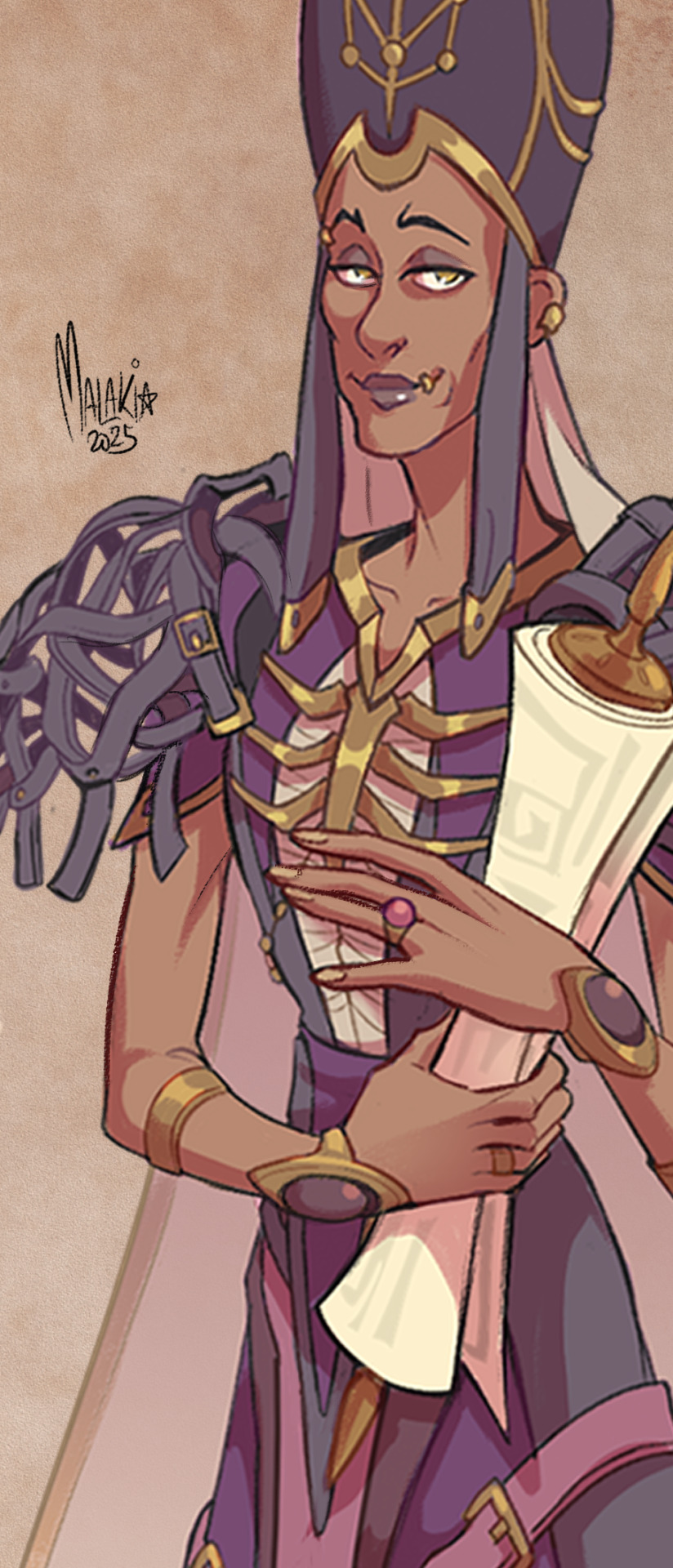
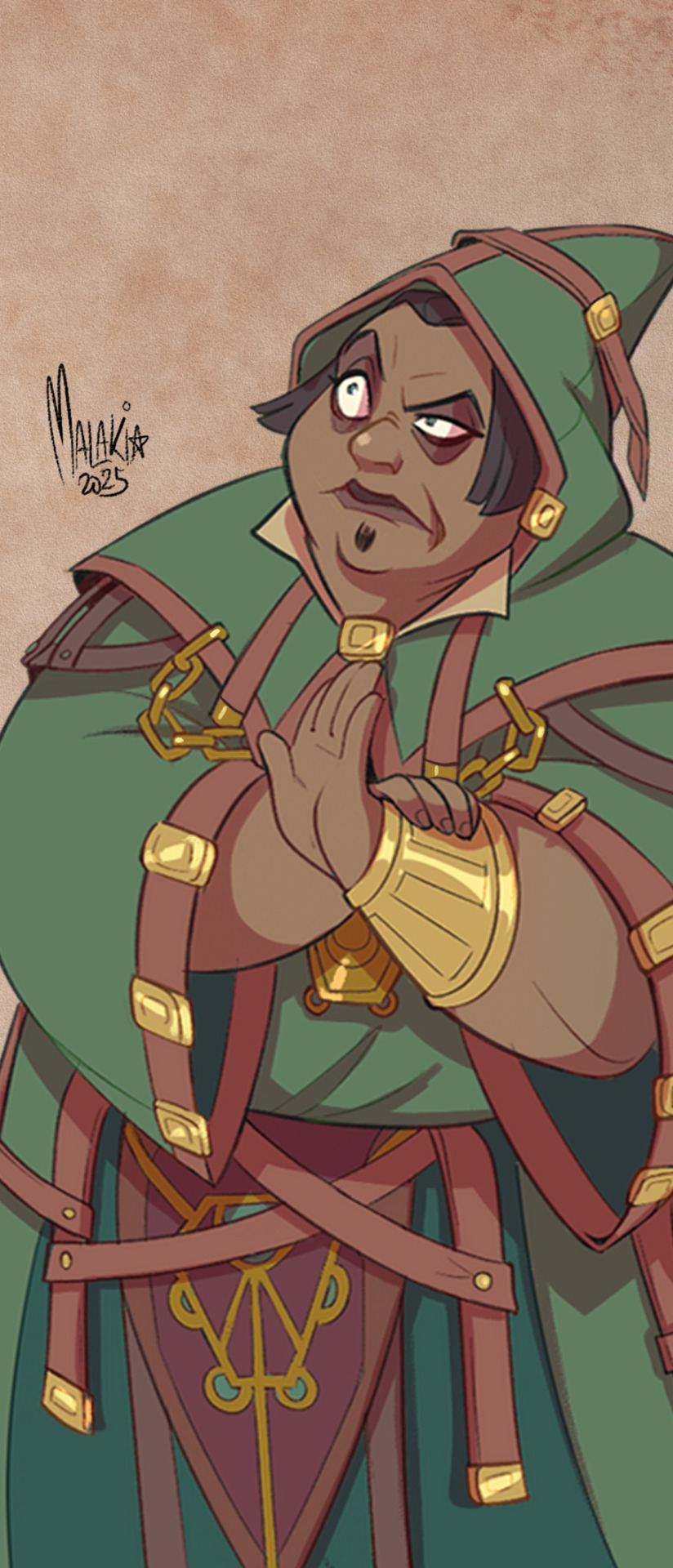
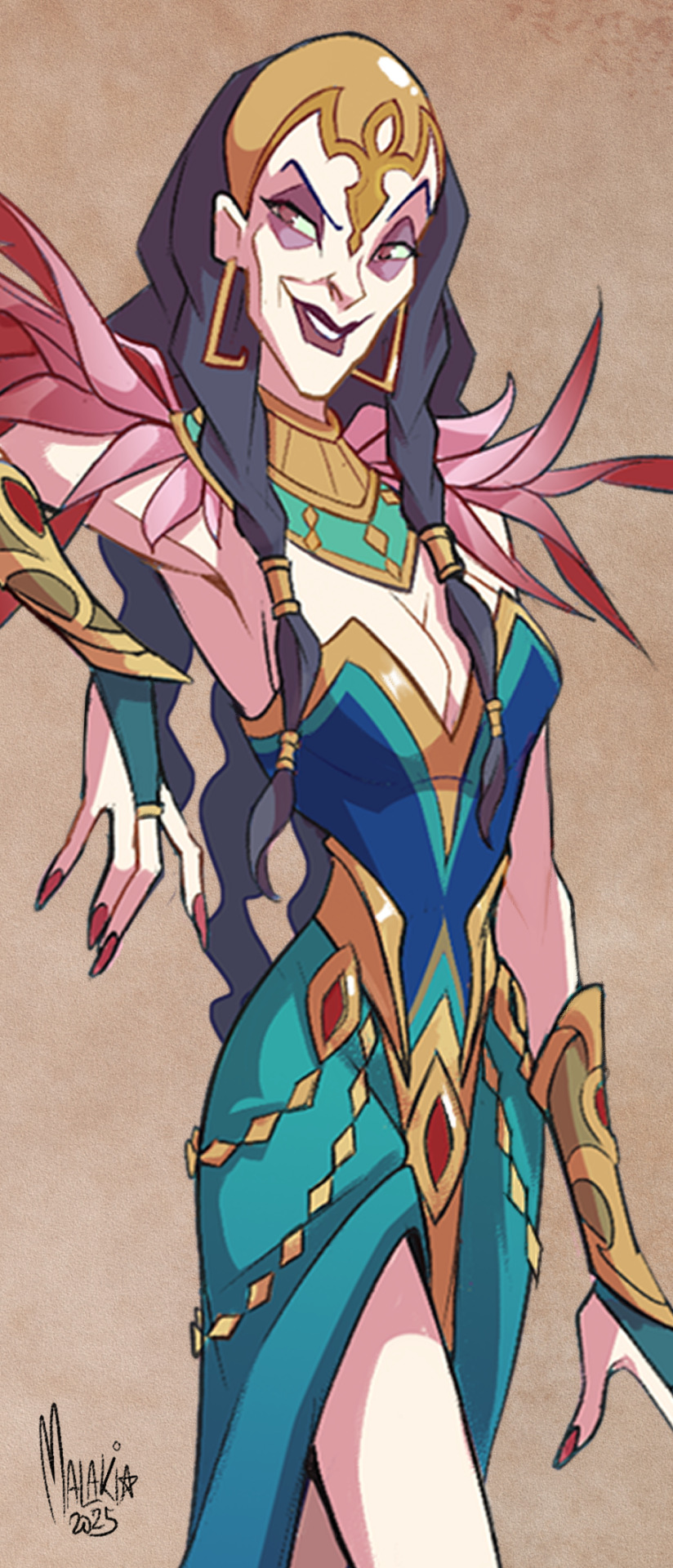
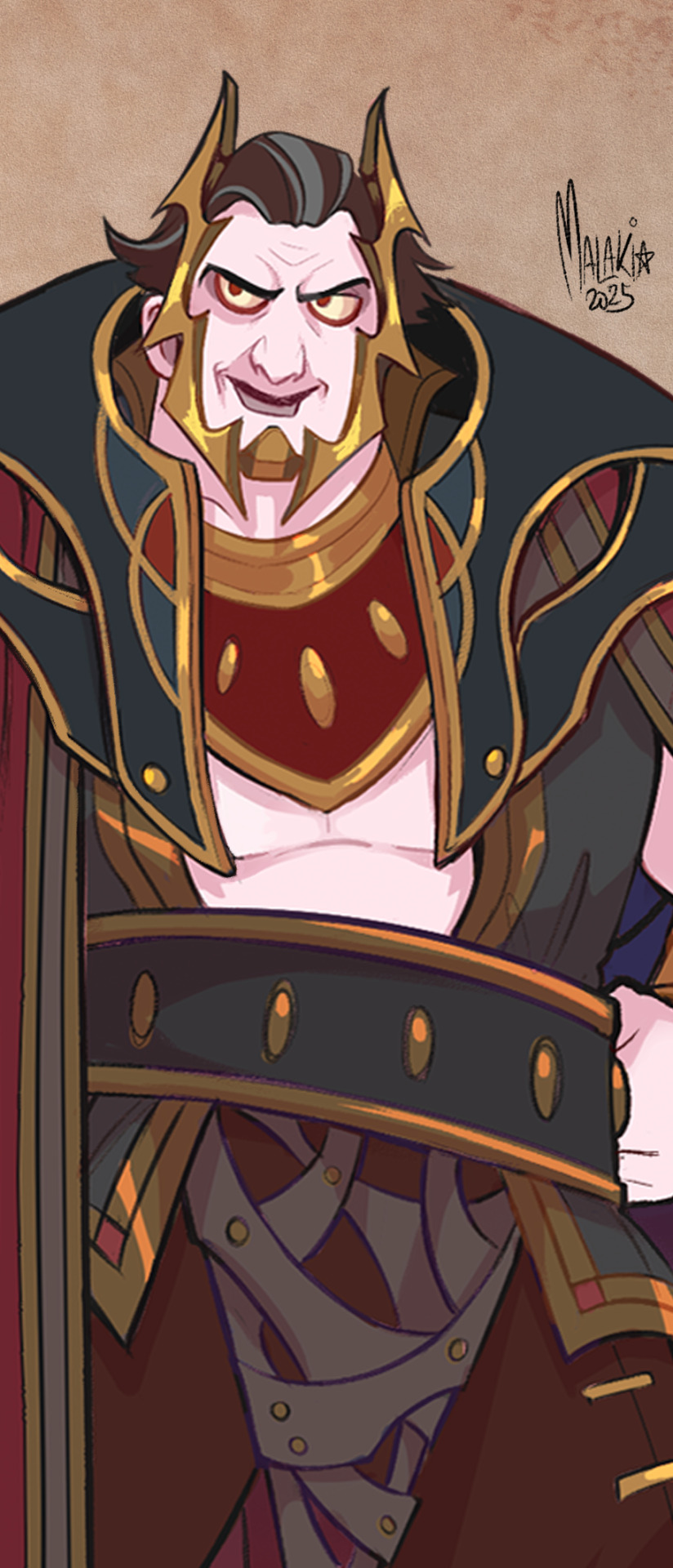
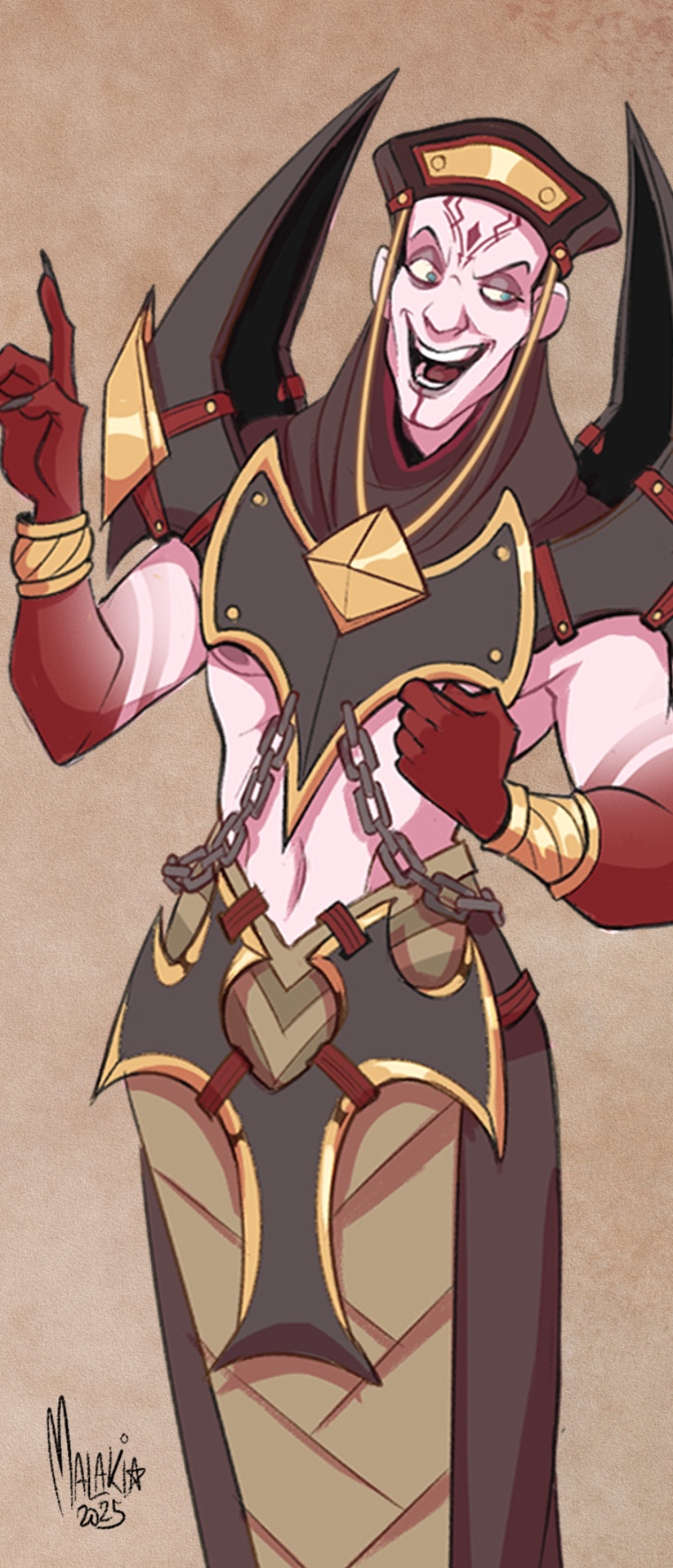
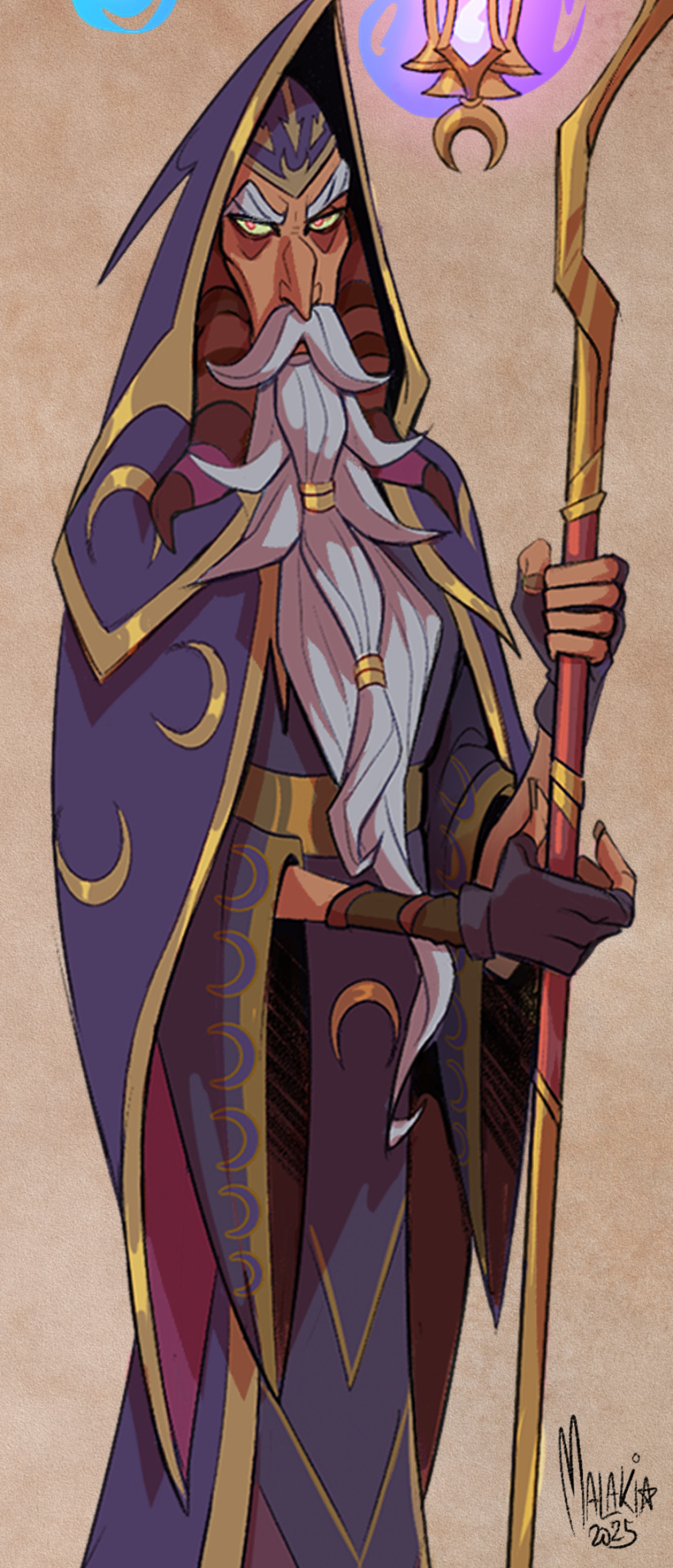
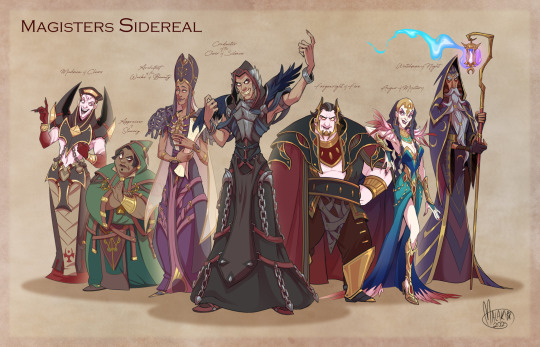
[ - Magisters Sidereals - ]
And each was promised Power and glory beyond all reckoning If they would only come to the feet of the gods and ask. And so they joined in secret, telling none Who were not of the temples of their designs. And in Minrathous, in the heart of the Archon a sliver of fear grew, Stabbing like a wound. Though he knew not why. —Silence 1:1-1:17, Dissonant Verse
They'll be featured in some Fade/flashback scenes later on in my fanfic 'Nothing but ambition where hearts once beat' so I decided to come up with some fun designs for these 7 bastards ♡
I was definitely going for that "you're playing with the big boys now" vibe from Prince of Egypt, lmao.
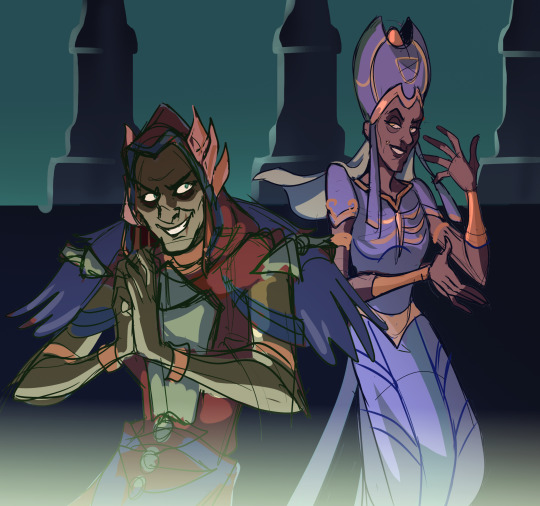
#dragon age origins awakening#dragon age origins#Dragon age art#Dragon age fanart#datv critical#Chant of Light#magisters sidereal#Tevinter Imperium#The Architect#Corypheus#Dragon age the Architect#DAO#DA2#Tevinter Old gods#Urthemiel#Dumat#razikale#Lusacan#Zazikel#Toth#Andoral#da fanfic#veilguard critical
214 notes
·
View notes
Text
{Spoilers-Theory} Old Gods = Elvhen Gods Part 3 1/2
Originally posted 1st April 2024
I must apologise for the delay -- RL got away from me but I'm back for Part 3! Buckle up because we are going to deep dive into the deepest roads of the fade where Epiphany dwells.
I had planned on delving headlong into the coincidental similarities between the Old Gods and Evanuris and positing my own individual matches, citing connections and contradictions for each however I believe there is still much more contextual evidence to support and weaken the theory before that so...welcome to Part.3
Recap for Part 2:
Solas personally does not consider himself one of the Evanuris.
Mythal was considered one of the Evanuris. One of the best of them.
Honourable mentions:
Evanuris and The Forgotten Ones
{Elvhen, God-Spirits and the Maker}
Gaider and the BioWare team have outdone themselves with the creation of such a diverse and complex setting as Thedas. Codex entries give us passive insight and world-building without the use of exposition and railroading the storyline – allowing us to consume the information at our own leisure. It's within these Codex entries that we find the most worldbuilding and contextual information rather than the narrative of any given instalment with the Dragon Age franchise. Creatives have used RL events, religions and mythologies as the basis for fictional works for hundreds, if not thousands of years. Dante’s Inferno could be considered one of the earliest known self-insert fanfics in the modern era. George RR Martin’s A Song of Ice and Fire has many parallels with numerous mediaeval historical events, including but not limited to the Hundred Years War and the War of the Roses.

[Illustration of ‘The Hero’s Journey’ from Wikipedia; here]
The monomyth itself describes the common heroic narrative and cannot at all be directly connected to the multiple religions that it is present in, surely? In essence - no. The ‘Hero’s Journey’ formula is perhaps older than organised religion and as old as the human race itself, and its presence is so widespread is perhaps a product of the great global journey as modern humans migrated out of Africa.
The monomyth is an example of something pre-existing being adopted and adapted by multiple cultures. In the ancient world, this also included adopting and adapting deities, especially if their roles were similar. Perhaps evolving from the same root, as observed by the Roman and Greek pantheon?
If we look at RL mythologies and how they evolved we can perhaps gather some insight into how Thedosian cultures and mythologies evolved outside of canon information garnered from in-game codex or literature.
Polytheism has two subcategories; hard polytheism and soft polytheism. “Hard” polytheism is the belief that all deities are distinct and separate rather than considered to be archetypes or personifications. “Soft” polytheism, also known as omnitheism, posits that different gods may either be archetypes, personifications of nature, or essentially the same god but interpreted differently by different cultures.
If the Old God = Elvhen God theory is proven to be true, this would be a case of omnitheism.
Apart from the Old God = Elvhen God theory, soft polytheism is prevalent in Thedas and Dragon Age. This is seen in human tribes that either predate and/or fall outside of the Andrastianism and the Chantry, especially the Avvar and Chasind as their practices have endured into the Dragon Age.
The Avvar and Chasind are sister cultures, both descending from the ancient Almarri before splintering off into the Frostbacks and the Korcari Wilds, respectively. As sister-cultures they have diverged and evolved unique practices, however they both come from the same root and retain similarities, most notably the shamanistic traditions and shared spirit-gods such as Korth the Mountain-Father, The Lady of the Skies and Hakkon Wintersbreath.
Although it has been previously alluded to in codex entries, the Jaws of Hakkon DLC for Inquisition gave us a first-hand experience of enduring ancient human customs as practised by the Avvar and how spirits and magic play an integral part in their traditions.
The three principal gods of the Avvar; Korth the Mountain-Father, Lady of the Skies and Hakkon Wintersbreath would be considered personifications of nature. Korth = Earth. Lady of the Skies = Sky. Hakkon = Winter/War.
Amund, the Sky Watcher we encounter in the Fallow Mire in the Inquisition base game has this to say about your encounter after defeating the Avvar and rescuing the agents:
Sky Watcher: Is this why the Lady of the Skies led me here? To help heal the wounds in her skin?
This dialogue compounds the personification aspect of soft polytheism of the Lady of the Skies, and by extension the entirety of the Avvar pantheon and how the Avvar perceive lesser spirits. It can only be assumed that the Avvar believe that all spirits - at least benevolent spirits that aid the Hold - are gods as per The Augur’s dialogue in the JoH DLC:
General: What was that? Those spirits? Inquisitor: Did you just… introduce me to spirits? Augur: The gods of the hold clamoured to see you. I obeyed, for I am their voice and their augur. And if I didn’t show you off, they’d hound me for months.
General: You said I “blaze like fire”? Inquisitor: What did you mean when you said I blaze like a fire? Augur: How do you think you appear to the gods of the Fade? To those beyond the Veil, your hand burns like the watchman’s bonfire.
Confused: Spirits see me? All the time? Inquisitor: Are you saying every spirit in the Fade knows where I am? Augur: Only those nearby, but thoughts spread quickly among the gods.
The very nature of spirits is hard to define due to how little we know, either due to erasure or conflicting information, and how integral they seem to be to the Fade and the various cultures in Thedas.
Spirits are denizens of the Fade and are formed by reflecting the material world through the narrow lens of its nature. A spirit’s nature can be nearly anything; compassion, wisdom, justice, valour, faith, choice etc. Most negative emotions; despair, envy, desire, rage, terror etc. are nowadays considered demons. Demons are typically created when a spirit's nature cannot be fulfilled and is therefore corrupted, although Solas explains it best in dialogue. The dialogue will be a mix of freely triggered conversations between the PC (Female Lavellan)/Solas and Solas’ personal quest dialogue branches, so I will try to keep them in chronological order of availability.
Herald: I’d like to know more about the Breach. Solas: Simply put, it is a tear in the Veil between this world and the Fade, allowing spirits to enter the world physically. Small tears occur naturally when magic weakens the Veil or when spirits cluster at an area that has seen many deaths. Herald: I’d like to know more about the Veil. Solas: Circle mages call it a barrier between this world and the Fade. But according to my studies in ancient elven lore, that is a vast oversimplification. Without it… Imagine if spirits entered freely, if the Fade was not a place one went but a state of nature like the wind. Option 1: That sounds marvellous. Herald: It sounds like it would be wonderful. Solas: And dangerous, but… yes. A world where imagination defines reality, where spirits are as common as trees or grass. Instead, spirits are strange and fearful, and the Fade is a terrifying world touched only by mages and dreamers. I am glad that I am not alone in seeing the beauty of such a world, along with the obvious peril. Option 2: That sounds strange. Herald: I don’t know if I can imagine that. Solas: Try. Imagine if spirits were not a rarity but a part of our natural world like… a fast-flowing river. Yes, it can drown careless children, but it can also carry a merchant’s goods or grind a miller’s flour. That is what the world could be, if the Veil were not present. For better or worse. Option 3: That sounds dangerous. Herald: We’ve got enough trouble with demons already. Solas: But would they still be demons? Or would they be part of our natural environment like… a fast-flowing river? Yes, it can drown careless children, but it can also carry a merchant’s goods or grind a miller’s flour. That is what the world could be if the Veil were not present. For better or worse.
This conversation tree is available from Haven and focuses more on the Breach and Veil, however, we do find out later in Trespasser that the Veil is an artificial construct of Fen’Harel’s design and we must take into account its influence on spirits and demons, even the very Fade itself. What we later come to know is that Solas is describing not what the world could be but rather what the world should be without the Veil’s influence upon Thedas and the Fade.
Herald: I’d like to know more about demons. Solas: Your Dalish say that demons hate the natural world and seek to bring their chaos and destruction to the living. Solas: But such simplistic labels misconstrue their motivations and, in so doing, do all a great disservice. Spirits wish to join the living, and a demon is that wish gone wrong. Option 1: Can we change that? Herald: Is there a way to coexist? To live with them, if not in peace, at least without such active confrontation? Solas: Not in the world we know today. The Veil creates a barrier that makes true understanding most unlikely. But the question is a good one, and it matters that you thought to ask. Option 2: I don’t believe that. Herald: I doubt those things pouring out of the Breach wanted to join the living. Eat, maybe. Solas: Of course demons are destructive. This world is illicit and unnatural for them. They fight to gain entrance, and when the rules of this world do not mirror theirs, they lash out. Tragic, but not evil. Option 3: I don’t care. Herald: It doesn’t matter why they attack us. Solas: Of course it does. The dog that bites you because it is rabid is not the dog that bites you because it is starving. You may kill either, but one is just a few scraps of meat away from being your faithful servant.
Again, this conversation is available from as early as Haven. “Spirits wish to join the living, and a demon is that wish gone wrong.” is a line that sticks with me, as it's often the dialogue branch I choose, and it explains the difference between spirits and demons without the use of metaphor or allegory. The other options use metaphors but do illustrate the need for fluid thinking and adapting to the circumstances of any given situation when dealing with a spirit.

[Memory transforms into a Pride Demon from Dragon Age: Absolution]
With that being said it can be assumed that spirits are the default state, and demons are the ‘altered’ state, the antithesis. But that oversimplification doesn’t explain the existence of wisps and the other states of being that a spirit can enter, as Solas explains in dialogue in his personal quest All New, Faded for Her.
Solas: You were a true friend. You did everything you could to help. I could hardly abandon you now. Inquisitor: I’m here for you. (Flirt) (Female Elf PC) [Investigate.] 1. Where were you? 2. What is death like to spirits? So it isn’t really dead? (Special) (Triggered by previous) Investigate, Option 1: Where were you? Inquisitor: Where did you go? Solas: I found a quiet spot and went to sleep. I visited the place in the Fade where my friend used to be. It’s empty, but there are stirrings of energy in the Void. Someday something new may grow there. Investigate, Option 2: What is death like to spirits? Inquisitor: What happens when a spirit dies? Solas: It isn’t the same as for mortals. The energy of spirits returns to the Fade. If the idea giving the spirit form is strong, or if the memory has shaped other spirits, it may someday rise again. Investigate, Option 2, follow-up: So it isn’t really dead? Inquisitor: You’re saying your friend might come back? Solas: No, not really. A spirit’s natural state is peaceful semi-existence. It is rare to be able to reflect reality. Something similar may reform one day, but it might have a different personality. It would likely not remember me. It would not be the friend I knew.
The knowledge we can garner from Solas is unique, as he’s an ancient elvhen, and therefore it predates the chantry and lacks censure. Wisdom’s demise is tragic, and although something in its place will reform it will not necessarily be the same. That begs the question; is a clone the same person? Genetically they are identical but they lack the same personality characteristics and experiences that have shaped and defined them then are they fundamentally two different entities?
Solas believes it to be so; the same locale in the Fade, the same knowledge and memories could shape the energies but if the fledgling spirit lacks the memories of their friendship, those experiences they shared, then this newly sentient spirit would be a stranger. Even if this new spirit retained their memories, would the trauma of their predecessor’s demise fundamentally alter their personality?
Solas’s responses between Option 1 and Option 2 leave it open for either to occur; that a new spirit of wisdom will form or his friend will reform; ‘it may someday rise again’.
It is open for interpretation, however, there is evidence that individual spirits can linger and retain their sense of self after their demise.
"A great deal is made of the most powerful demons, those that create abominations and those that have changed the history of Thedas. It is often forgotten that not all demons are such awe-inspiring beings. Some that break through the cracks in the Veil into our world are known as wisps, a sliver of a thought that once was. A wisp is a demon that has lost its power; either it has existed in our world for too long without finding a true host or it has been destroyed—often, so we've found, by other demons. What remains of its mind clings tightly to the one concept that created it—a hatred of all things living. While its ability to target a living creature is limited, these wisps often mindlessly attack when encountered in the Fade. In the living world, they often have been known to maliciously lure the living into dangerous areas, being mistaken for lanterns or other civilized light sources. This does, however, seem to be the very limit of their cunning." —From the journal of former Senior Enchanter Maleus, once of the Circle of Rivain, declared apostate in 9:20 Dragon Age
The codex entry for wisps in DAO, is unlocked after defeating a wisp wraith. Due to the codex author we must take it with a grain of salt, even though the Rivaini are more liberal they are still influenced by the Chantry, so do we choose to believe that wisps are only the remains of ‘malevolent’ demons or is it a state of being that all spirits can enter?
Are wisps solely the remains of ‘that once was’? The short answer is; that we don’t really know. The Wraith codex entry in DAI has this to say:
Like wisps, wraiths are sometimes thought to be the remains of spirits or demons that have been destroyed. They cannot shape the Fade around themselves, nor are they capable of mimicking forms they see in the minds of dreamers as many weaker spirits do. Instead, they are the scavengers of the Fade, dwelling in the shadows of stronger beings, feeding on scraps of thought and emotion. —From Beyond the Veil: Spirits and Demons by Enchanter Mirdromel
Now we know from World of Thedas Vol. 2 that the book quoted in the wraith codex is canon to Thedas and is ‘Chantry approved’. If we compare the information between the wisp and wraith codex, we can see that they both agree that wraiths and wisps are thought to be ‘the remains’ of spirits or demons and lack any true power to exert their will upon the Fade.
Gathering his magic, he reached his mind across the Veil and summoned a spirit through. It was tiny, a wisp of a creature with barely any consciousness to call its own. The shimmering orb hovered over the palm of his hand, its magical hum tickling the hairs on the back of his neck. “I need you to be quiet,” he whispered. “You can do that, can’t you?” The wisp bobbed excitedly and dimmed. He barely even saw it now. Tossing it up into the air, he sensed its excitement as it floated out into the commons. Even such a small spirit took great joy in coming into the real world. They found the oddest things of endless fascination; a wooden chair, a piece of steak, a feather. Left to its own devices, a wisp would bob around random objects for hours, making strange trilling noises as it explored its environment. The templars frowned on the use of even such benign spirits, although it was not strictly forbidden. The best healers, after all, summoned spirits of compassion to assist them. Such spirits did not linger and immediately returned to whence they came, but the Chantry looked upon any who had the talent to contact them with suspicion - such as himself. Still, it had its uses. [Excerpt from Dragon Age: Asunder. David Gaider. Pg. 58.]
In Asunder we see Rhys summon a spirit, it is described as ‘a wisp of a creature’, so is it a wisp or a spirit or are they interchangeable? Is a wisp just a spirit or demon that lacks a complex consciousness? What we do know, thanks to more recent Dragon Age media such as the novels that I am referencing, is that wisps can be summoned and they can be bound, and therefore follow the same laws as spirits and demons. In the short story The Dread Wolf Take You, from the Tevinter Nights collection, a Mortalitasi has bound what has been described and referred to in dialogue as a wisp.
“Interesting to see both Dalish and city elves working with this… thing.” The Mortalitasi grimaced, and then her eyes snapped down to her stirring stick, still moving of its own accord in her wineglass. “I see specks at the bottom, wisp.” Her voice held a warning, and the stirring stick jerked and moved faster. [Excerpt from Dragon Age: Tevinter Nights. The Dread Wolf Take You, Patrick Weekes. Pg. 491]
This wisp has been bound to a stirring stick to animate the object, a simple task, something that Rhys in Asunder mentions that is within a wisp’s capabilities.
At once, we were awake, back in the cavern, and its walls shook and cracked, and then a rift of green light rent the ceiling open above us and the demons that had accompanied the Dread Wolf burst into the world in righteous fury, shining warriors with blades forged from the raw Fade itself, and behind them, dimly visible through the crackling light, the shadow of the beast itself, from whose slavering jaws came the final words, roared not in anger, but with quiet contempt. “FROM THIS MOMENT, SHOULD YOU EVER BIND A SPIRIT, THEN YOUR LIFE IS MINE.” The hypocrisy almost made me laugh. The Dread Wolf forbade use from binding spirits, but why would these lesser demons attack us if not because the Dread Wolf bound them? They might have looked like spirits of Valor or Justice to the untrained eye, but I assure you, no kindly spirit would tear into us as these creatures did. [Excerpt from Dragon Age: Tevinter Nights. The Dread Wolf Take You, Patrick Weekes. Pg. 496-497]
Later in The Dread Wolf Take You, in The Mortalistiasi’s Tale we have ‘The Dread Wolf’ declare that if the Mortalitasi were to bind any spirits from that point on then their life is forfeit. This threat comes to pass later in the story and Solas releases the wisp/spirit from the stirring stick.
So we have gathered that although wisps and wraiths are ‘sometimes thought to be the remains of spirits or demons that have been destroyed’, they could potentially be the stirrings of a consciousness of a newly formed spirit? The latter has no basis other than the supposed ‘life cycle’ of a spirit in Solas’ dialogue in All New, Faded for Her, but it could be the reforming of a pre-existing consciousness. It would seem that spirits are immortal, akin to the mythological phoenix.
The franchise does have an instance similar to that of a reformed spirit regaining its consciousness. Mythal.
We discover in the main quest, The Final Piece, that Flemeth is Mythal or more accurately that Flemeth is Mythal’s mortal host. I will be referencing dialogue trees for a world state that has an Old God Kieran and the Elven Inquisitor drinks from the Well, with the help of The Genitivi Chronicles.
Inquisitor: You can’t be Mythal! That’s not possible! Flemeth: (Laughs.) Explain to me, dear (girl/boy), why I cannot be what I am. 1. I know what Mythal was. (Special) (If Elven PC) 2. You’re not even elven. 3. You’ re no god. 4. Mythal is long dead. Option 1 Inquisitor: Mythal was the goddess of justice. I’ve seen the statues. She…Flemeth: Was one of the People. Yes, indeed. Option 2 Inquisitor: Mythal was an elven god. You, you’re… Flemeth: Human? Flemeth laughs. Flemeth: Not a word many have used for me in a very long time. Option 3 Inquisitor: I’m supposed to believe that you’re some kind of god? Flemeth: Clearly not the sort you had in mind, hmm? Option 4 Inquisitor: Whatever Mythal was, she died long ago. Flemeth: So she did.
Option 1 and Option 2, have the characters confirm what we can deduce by observation. Mythal was elvhen. Flemeth is (or was) human. Option 4, on the other hand, confirms what Abelas had claimed in the Temple of Mythal that Mythal had been murdered, unlike the Dalish legend that she was banished to the Beyond with the Evanuris.
That confirmation that Mythal had died is crucial, and I will explain as to why later. The conversation that takes place within the Fade (as per the Old God Kieran world state) between Mythal, Morrigan and the Inquisitor is illuminating.
Flemeth nudges Kieran, and Kieran rushes over to hug Morrigan. Kieran: I’m sorry, Mother. I heard her calling to me. She said now was the time. Morrigan: I do not understand. Kieran returns to Flemeth’s side. Flemeth: Once I was but a woman, crying out in the lonely darkness for justice. And she came to me, a wisp of an ancient being, and she granted me all I wanted and more. I have carried Mythal through the ages ever since, seeking the justice denied to her. 1. She’s inside you? 2. This is too much. 3. Maybe that was a demon. Option 1 Inquisitor: Then… you carry Mythal inside you? Flemeth: She is a part of me, no more separate than your heart from your chest. Option 2 Inquisitor: You can’t expect us to believe that. Option 3 Inquisitor: That could have been a demon, lying to you.
…crying out in the lonely darkness for justice. And she came to me, a wisp of an ancient being… I have carried Mythal through the ages ever since, seeking the justice denied to her. Now this dialogue is either a great big fat red herring or it seems like Mythal is acting eerily similar to a destroyed spirit that has clung on and reformed into a wisp, hmm?
Flemeth: What do the voices tell you? The Inquisitor closes their eyes, listening to the whispers. Inquisitor: They say you speak the truth. Flemeth: But what was Mythal? A legend given name and called a god, or something more? Truth is not the end, but a beginning. Flemeth: So young and vibrant. You do the People proud and have come far. Flemeth: As for me, I have had many names. But you… may call me Flemeth. 1. Will you help us? 2. Am I your servant now? 3. What do you want? 4. Why stay secret? (Investigate) (Non-Elven PC) 5. You’re Morrigan’s mother? (Investigate) (Elven PC) - I need to understand. (Investigate/Special) (Triggered by either previous question) 6. The elves needed you. (Special) (Elf PC) 7. I know who Flemeth is. (History) Option 1 Inquisitor: I presume you know what we’re up against. Flemeth: Better than you could possibly imagine. Inquisitor: So will you help us? Flemeth: Once I have what I came for. Flemeth looks at Kieran. Option 2 Inquisitor: So must I serve you now because I drank from the Well? Flemeth: (Chuckles.) Is that how you see yourself? A servant? I have no commands for you. Not yet. Morrigan: Then what is it you want? Flemeth: One thing, and one thing only. Flemeth looks at Kieran. Kieran looks to Morrigan. Kieran: I have to go now, Mother. Option 3 Inquisitor: So you lured us here. What do you want? Flemeth: One thing, and one thing only. Flemeth looks at Kieran. Kieran looks to Morrigan. Kieran: I have to go now, Mother. Option 4 (Non-Elven) Inquisitor: If Mythal is within you, why not reveal yourself? Flemeth: And to whom should I reveal myself? Inquisitor: To the elves? To everyone? Flemeth: (Laughs.) I knew the hearts of men even before Mythal came to me. It is why she came to me. They do not want the truth, and I… I am but a shadow, lingering in the sun. Option 5 (Elven) Inquisitor: Then you’re Mythal and Morrigan’s mother? Morrigan: As well as a witch who prolongs her unnatural life by possessing the bodies of her daughters. Flemeth: That’s what you believe, is it? Morrigan: I found your grimoire, and I am no fool, old woman. Flemeth: (Chuckles.) If only that were so. My daughter ran from me long ago. I’ve let her be… until now, it seems. Option 5 (Triggered) Inquisitor: If Mythal is within you, why not reveal yourself? Flemeth: And to whom should I reveal myself? Inquisitor: To the elves? To everyone? Flemeth: (Laughs.) I knew the hearts of men even before Mythal came to me. It is why she came to me. They do no want the truth, and I… I am but a shadow, lingering in the sun. Option 6 Inquisitor: If Mythal is a part of you, why haven’t you helped us? We’ve called to you, prayed to you… Flemeth: What was could not be changed. Inquisitor: What about now? You know so much… Flemeth: You know not what you ask, child. Option 7 (If Elven) (History) Inquisitor: I know the name “Flemeth.” My people call you Asha’bellanar, the woman of many years, and speak of your legend. Inquisitor: It says, long ago, you left your husband for a lover. Your husband then tricked you, killed your lover, and imprisoned you. Then a spirit came to offer you vengeance. Mythal–that’s what you spoke of. Flemeth: One day, someone will summarize the terrible events of your life so quickly. But, yes, I was that woman. That is how my tale began. Inquisitor: Flemeth appears in other legends, helping heroes for reasons of her own. Flemeth: I nudge history, when it’s required. Other times, a shove is needed. (Chuckles.)
The initial dialogue tree after discovering that Flemeth is Mythal is a minefield of information that needs to be pieced together, it is such a shame that this tree cannot be exhausted and you must choose a branch. Option 1 has me curious, as this is during the Breach Crisis, the danger that Corypheus poses with his plan to assault the Black City with the aid of the Orb of Destruction, it seems that Flemeth is familiar with what? Corypheus? The Blight? The Orb? The Veil?
Option 2 and Option 3 offer little, except to reaffirm Flemeth’s interest in an OGB Kieran and that she now has control over the person who has drank from the Well of Sorrows.
Options 4 and Options 5 are dependent on the race of the Inquisitor. Option 4 leaves us with more questions after Flemeth answers the PC cryptically. What is not mentioned in this branch is Flemeth is known to the Dalish as Asha’bellinar, the Woman of Many Years, if you trigger the Investigate - History option, aka. Option 7 then your PC regurgitates the legend of Flemeth and in my personal opinion, organically triggers Morrigan’s mention of how she, wrongly, believes Flemeth extends her life. ‘Then a spirit came to offer you vengeance’, this reaffirms the theory that whatever Mythal is now could be considered a spirit or a demon, depending on how we classify vengeance.
But that begs the question: are the Elvhen spirits made flesh?
Part 3 has been split up into multiple parts as it grew into a monster. Stay tuned for Part 2/2!
#Bor-Dirth'ena#dragon age#spoiler warning#dragon age theory#tevinter old gods#evanuris#elvhenan#BDTinFoilTheories
2 notes
·
View notes
Text
A Theory Regarding THAT Archdemon Reveal
Massive spoilers for some Veilguard lore revelations, read ahead at your own risk!
When Solas reveals to us that the Archdemons are dragon thralls to the Evanuris that only exist to sustain their invulnerability (kinda like...uh...horcruxes essentially), we also got the tidbit that Razikale and Lusacan correspond to Ghilan'nain and Elgar'nan, respectively.
At first I was like...wait...isn't Dumat supposed to be the main Old God, not Lusacan? Why would Elgar'nan let anyone but himself (or his dragon in this case) be viewed as the main dragon god?
Later we find out that Dumat may have perhaps been the dragon of Dirthamen. The analogy makes sense, Silence and Secrets, certainly not as much of a mental exercise as Chains and Hunting for Andoral and Andruil.
But why would DIRTHAMEN'S dragon be seen as the main god? I tried to resonate that with myself, until something crept into my mind:
It is written in ancient history that the first Tevinter dreamers ventured into the Fade, where they encountered the Old Gods. Dumat happened to be the first one they came across, and everything began from then onwards.
So did Dirthamen just happen to come across the dreamers before any of the other Evanuris and quickly pulled a power move to establish himself as the mighty god king? And when Elgar'nan finally showed up, it was already too late?
But why would Dirthamen even do something like that? Why risk Elgar'nan's wrath like that? They were all trapped in the Black City after all. Why would Dirthamen suddenly want to seize power like that? What could motivate him?
Then I came across this little tidbit of Dirthamen lore that Morrigan drops us later in the game:
Dirthamen and Falon'Din were once one spirit, and something caused them to split apart and form two different beings.
This got me thinking. What exactly could have once been a being that combines both Knowledge and Death? And more so, what could have fractured that being?
Then...a thought hit me.
What if Dirthamen/Falon'Din...I'm gonna call him Dirthadin for now, was the original most powerful of the spirits that would eventually become the Evanuris? What if Dirthadin was the one to originally rule them all? And what if Elgar'nan pulled some Greek mythology type shit and overthrew him to cease power for himself? What if there is more to the legend that Elgar'nan was known as "he who overthrew his father"? What if Dirthadin was that father?
When Dirthadin was split into Dirthamen and Falon'Din, Elgar'nan could have shaped and formed the two spirits to his will, making them "his sons" as the Dalish legends say. But some spark of the former Dirthadin remained, seeking absolute vengeance.
So when the time came to establish a new world order with Tevinter, Dirthamen made sure he was the first to contact the dreamers. When his effort was met with success, he declared himself as Dumat, the king of the dragon gods. And Zazikel, Falon'Din, his other half, became the second most powerful god. Everyone else just kinda followed along. And if the official Old God list indicates any kind of hierarchy, then Elgar'nan/Lusacan was put LAST. Oh what a torture, what an endless humiliation it would be for the lord of the Evanuris to be placed on the lowest of the divine pedestals.
In the end, Dirthadin had his final triumph, even in Thedas, as Dumat and Zazikel's Blights lasted the longest by far.
#dragon age#dragon age the veilguard#dragon age origins#datv#dragon age inquisition#dragon age ii#old gods#datv spoilers#fan theories#tevinter imperium#elgar'nan#dirthamen
74 notes
·
View notes
Text





Damn, and I thought I was down bad when Elgar'nan was talking to Mien.
#'your gods' as in tevinter old gods but also elven gods#the fact that ruq has elgar'nan's vallaslin makes it even more fitting#dragon age#dragon age the veilguard#veilguard#da rook#rook mercar#mercar#elf rook#proffbon oc ruquantriviel mercar#elgar'nan#dragon age the veilguard spoilers#veilguard spoilers#dav spoilers
35 notes
·
View notes
Text
I always find it a little funny and amusing the common "Corypheus's For I have seen the throne of the gods, and it was empty! is such a raw line, it goes so hard" because I've always been DEEPLY unimpressed with it. it comes across for me as super tryhard and edgy. I can't be impressed with it because it feels like it's TRYING to impress me, it's straining too hard to be A Good Line that it sounds forced. like, I don't even think it's the best line of that MONOLOGUE, let alone the whole scene.
#“I will not suffer even an unknowing rival” is a better line tbh#“I have gathered the will to return under no name but my own‚ to champion withered Tevinter and correct this Blighted world” is also better#it's also a bit of a ? when you remember Genitivi wrote that the Golden City and the Maker's throne was unattended after the First Sin#suggesting that at least SOME people in the south believe as is that the Golden City and the throne is empty#so like who is Corypheus trying to impress here. like yes you did find the Throne empty. some in the Chantry already say you did.#yes yes the silence of the Maker and his abandoned throne we all heard of it#(inb4: YEs I know he was following the Old Gods but he's trying to monologue about this at like the Chantry or someone representing it)#tbh now I'm thinking way too hard about this because— actually I won't get into dogma and theology and faith and Andrastianism#because the point really is more that this line doesn't impress me bc it's tryhard and less about its intersection with creeds#DA things
35 notes
·
View notes
Text
‘why would venatori (elf racist tevinter slavers) follow the elven gods?’ idk man, maybe it has something to do with lusacan and razikale, two old tevinter gods they praise in the game.
#PLEASE THE ANSWER IS RIGHT THERE. THEY ARE FOLLOWING THEIR OWN OLD TEVINTER GODS.#the evanuris literally taught humans magic and helped found the imperium. why do you think its so similar to elvhenan#venatori want the ‘old’ tevinter back. elly and ghilly are literally their old gods who helped founding that version of tevinter#and they want the entire world to be like that.#why WOULDNT they follow them. the evanuris dgaf about elves either way#da#dragon age#dragon age: the veilguard#datv#datv spoilers#veilguard spoilers
25 notes
·
View notes
Text
Dragon Age Iconic Patterns: The Sun

In this post I will try to extensively gather all the sun-based or sun-like imagery that we find in all the games of Dragon Age. From the most typical ones to those which may seem obscure or with a hidden allegory/design. I will qualify their resemblance with the Sun symbol as Strong, Weak or other.
This post contains the following symbols
Chantry Sunburst
Elvhenan Culture: Sun symbol among the Evanuris
Elvhenan Culture: Asterisk Symbol and Elvhenan Doors
Elvhenan Culture: Golden Ring
Elvhenan Culture: Crappy Sun
Elvhenan Culture: Elgar’nan and Sylaise
Elvhenan Culture: Murals
Tevinter Culture: Green Star
Tevinter Culture: different decorative elements
Dwarven Culture: Fairel and Dwarven art
Ferelden Culture: The Sun Face and the geometrical Sun
Grey Wardens and the Sun
Avvar and the Sun
Flemeth
Qunari, Par Vollen, and the Solium Constellation
DAO design
Free Marches Rural Areas
[This post belongs to the series “Analysis and speculation of Statues”]
[Strong] Chantry Sunburst
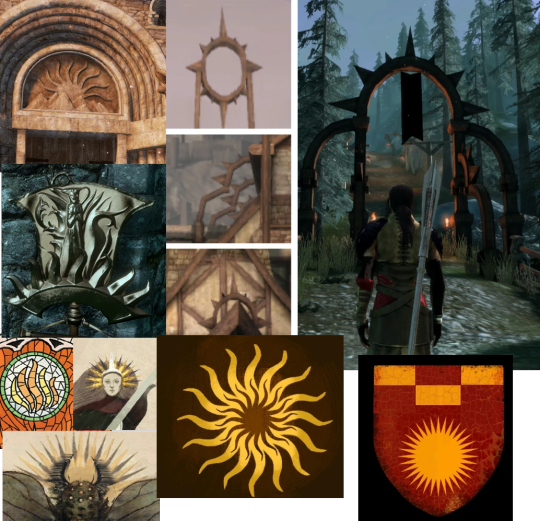
The most typical one that appears in DA series is the Sun or Sunburst with wavy rays, repeated so much along the games that we can identify it immediately. It’s the unequivocally symbol of the Chantry. We found it in many versions, and it represents the “dawn” with the idea of hope and “new beginnings”, but also the fire that “purified” Andraste in her pyre to let her ascend to the Maker’s side. In the posts of Andrastian Art [Andrastian Design: Stained Glasses], we also find that “balls of fire” [which can be interpreted as a Sun in another way] are shown to represent the Maker or the Faith in Him.
Andraste’s single spiked helm seems to be inspired in a single sun ray, at least this is what an illustration in the Chant of Light [book of World Of Thedas] seems to suggest.
In general, most of the representations of the Chantry Sun have 16 rays.
The same sun-like symbol appears in its Tevinter version when we see the Imperial Chantry; the only difference with the Orlesian one is that the Tevinter Sunburst has straight rays.
As a detail, in DAO, we had the typical representation of the wavy sunburst present in some strange devices of Tevinter origin, for example, the ones we found in [Brecilian ruins], while the main Church in Denerim, or in Haven, display spikes that, more than resembling a sun, look like thorns or even a thorny vine. This may be a consequence of an original plan in linking, design-wise, the chantry symbology with the thorny vines that represent the Blight or the Darkspawn [As we explained in the section “Non-mural symbol: Thorny vines” from Murals in DAI: Basics], or merely it was a limitation of the design of the game, as we know DAO suffers from.
We also know that tranquils should display this symbol on their foreheads, burnt with lyrium, but as we saw along DAO, none of them had it. Later we were informed that the devs had problems to add this mark on the npc, therefore, it was never shown until DA2. When it comes to this symbol, it is interesting to see that tranquils carry the metaphor of “a Sun burning their minds and emptying them”, which may or may not be related with Dwarves and their fear to the Sun and potential relatinship of Elgar'nar shoving a fire ball into their underground lands [More details of this concept in Deep Roads [DLC Trespasser]: Lower Walkways in particular with the codex Torn Notebook in the Deep Roads,].
[Strong] Elvhenan Culture: Sun symbol among the Evanuris
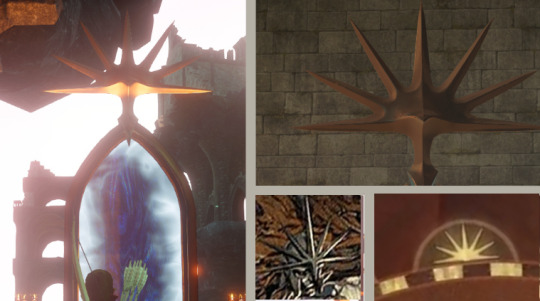
Strangely close to the Chantry Sunburst symbol, we find the “half” sun symbol [tagged along the blog as Sun-head creature] in what we suspect was one of the ancient primordial dragon symbols that some Evanuris took over when they claimed Divinity [for more context, read Attempt to rebuild Ancient Elvhenan History]. It’s hard to say which Evanuris took control of this symbol, but we know there is a clearly sun-like symbol present in the Crossroads of the DLC [as a statue, check The Crossroads [DLC Trespasser]: Entrance] and in the Shattered Library [as an Eluvian, check Shattered Library; Entrance and Courtyard]. With the release of the Vinyl, we also discovered and reinforced the hypothesis that this symbol belongs to or was co-opted by an Evanuris [read Speculations about the Vinyl Art for details] thanks to the image of an elf wearing a hat with that shape.
A consistent detail of this image is that it’s a half-sun with exactly 7 rays.
[Weak] Elvhenan Culture: Asterisk Symbol and Elvhenan Doors
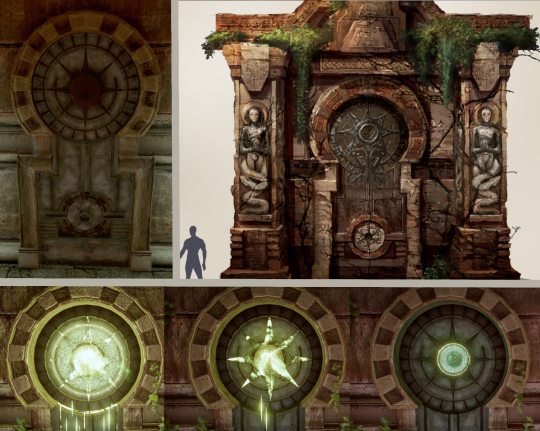
If we extend this imagery, and check other symbols that may look similar to a sun, we find the ancient Elvhenan Doors [Elven Ancient Shard-based door], which top displays a pointy sun of 8 rays that may or may not be related to the Asterisk symbols [also related to the Titan’s core, which I talked about in the post of Murals “The Death of a Titan”]. In the way the door gets illuminated when activated also makes us see a “circle” in it that can be loosely related to the “Golden Ring shape”. More details about this ring will be treated below.
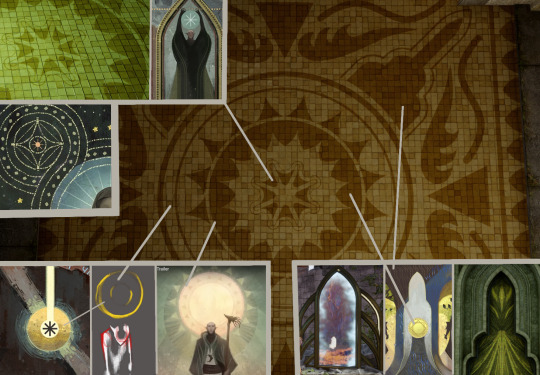
This strange sun on the ancient door also makes us think in the Asterisk Symbol [made of 8 points], which lays at the centre of the yellow mosaic, which may be related to the core of a Titan [asterisk of 8 points too]. The link is immediate when we see that this asterisk is outlined by a shape that looks like a star or a Sun, inside a big ball with triangular-shape ends. This same symbol appears in the last Trailer of DA4, behind Solas, when he is presented like an Hermit, mysterious, apostate mage. Around this “sun” we can make out several concentric lines that may refer to a “Golden Ring”.
The Asterik symbol also appears in murals such as “The Creation of the Veil” or “The Death of a Titan”, which allowed us to relate them with the core of a Titan and its immense power of "making real what you imagine"reinforcing the reality", but this symbol also appears in a corner of Solas’ tarot card.
The yellow mosaic also has some shapes at the four corners that may represent eluvians or something related to Mythal. In the mural of “the Temple of Mythal” from “The actions of the Inquisitor”, we see that Solas draw a particular star of 8 points inside a door frame that resembles this “eluvian outline”, but it’s also the shape of the doors of the Temple of Mythal which represents Mythal herself in her dragon shape. All these symbols seem to reinforce the idea we explored in “The Death of a Titan”: Mythal seems to be related to the core power of a Titan represented by an asterisk that evolves into a golden ring and into a sun.
As I repeated several times in Speculations about the Vinyl Art, at times, we find some hints where stars or balls of fires [also understood as suns] are related to Mythal and Elgar’nan, making us suspect that, maybe, Mythal and Elgar’nan share a nature similar to Falon’Din and Dirthamen’s: apparently, the same creature with two different aspects from them. If this were the case, associating Mythal with the Sun would make sense, and it would also explain why, if Elgar’nan was so central in the Elvhenan culture, there are so few representations and statues of him, while Mythal overwhelms it.
[Weak] Elvhenan Culture: Golden Ring
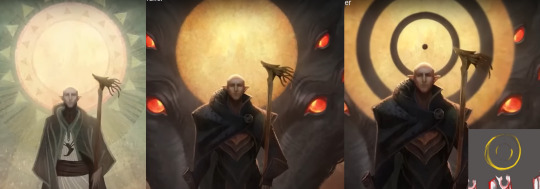
During the last trailer of DA4, we see Solas turns into the Black Dread Wolf as a sun in the background becomes a moon [single golden circle] and later, it separates itself into concentric rings, that may or may not be related to the “Golden Ring” so deeply entangled with Elvhenan culture. Thanks to this imagery, we may relate the Sun to the Golden Ring [specially if we consider that the mural presented in Nation Art: Elvhen displays the yellow ring in a position that may be considered “the sun”, but also the "authority/power above"]
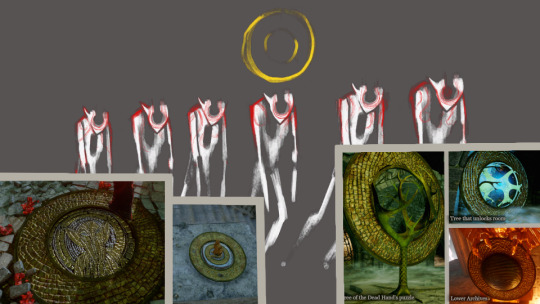
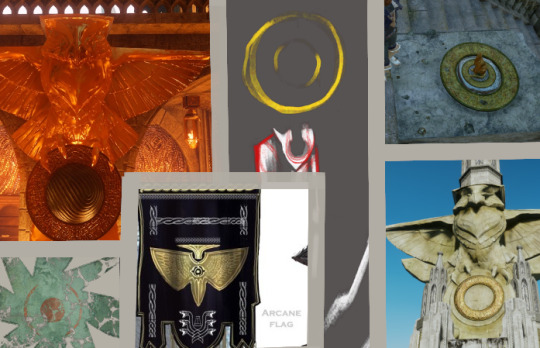
We need to remember that the Golden Ring’s presence is always associated with control, power, and occasionally to Mythal and Dirthamen. In the mural of the “zombie elves”, it’s above all of them, and due to this position, it could be interpreted like a “sun” or moon upon the controlled, zombified elves. But I’m not too convinced in this interpretation, since we already explored in posts such as: Nation Art: Elvhen, Exalted Plains: Ghilan’nain’s Grove and the Dead Hand, DLC: Jaws of Hakkon - Frostback Basin, Elvhen Tomb, Ancient Elven codices; Fen’Harel’s mountain ruins, The Crossroads [DLC Trespasser]: Elven Mountain Ruins; Vine-covered Tower, Murals in DAI: The Death of a Titan, and Speculations about the Vinyl Art that this ring was more related to control, power, or even forced change/shape in some cases. Due to its power or potential knowledge, it's also associated to Dirthamen Owl [which also could be Andruil's owl according some inconsistencies in the same Unreliable Dalish legends].
On the other hand, it’s never clear if this symbol may have morphed into a sun along the ages with the loss of memory that the Elves had throughout generations when they lost their immortality. However, I tend to consider that this Golden Ring may have changed into a Sun when it entered in contact with human groups, in the same way that I see the story of Fen'Harel gave enough context for humans to create the Maker myth based on him, potentially during the time of Halamshiral [for more details, read The Chantry and the Mythology of the Chant of Light]
This ring also appears in the last scene of DAI, when we defeat Corypheus, showing Mythal inside it, as bits of red lyrium sprout around it. This can be related to many speculations done in Speculations about the Vinyl Art, where we can conclude that another fragment/part of Mythal is still trapped in the Black City, corrupted, and contained by an immense power that may have been used before by the rest of the evanuris to control their own people.
The Golden Ring has also been seen enclosing Elven Tree Statues and Elven Orbs, implying its relationship with elvhenan power and/or Mythal’s [after all, we know that Mythal took the power from a Titan from which elvhen orbs were developed, and trees are also her symbol, according her vallaslin]. It's worth noting that the only working orb we saw in the game was Mythal’s, so far.
[Weak] Elvhenan Culture: Crappy Sun
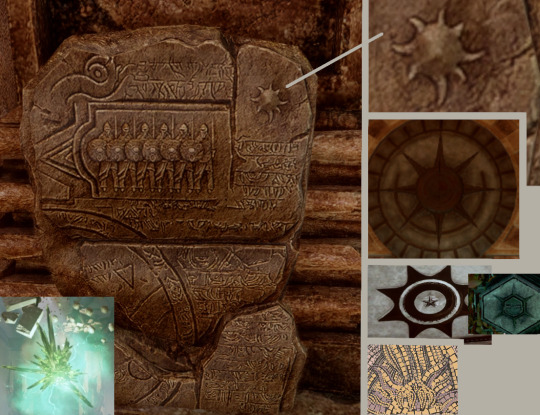
There is also a strange symbol that I called “crappy sun” in the ancient tablet we find at the entrance and deep into the tomb of Forbidden Oasis: Solasan Temple [along this blog I’ve tagged it as “Stone in Razikale-Ceremony-style”]. It’s hard to say if it represents a sun or a breach. It may be related to a sun similar to the one of the Elven Ancient Shard-based door that, later, Tevinter co-opted to turn into the several versions of pointy suns we see in Tevinter Pre-blight ruins, [let’s remember they were not Andrastian yet, and still they had this symbology in their buildings and elements because it may have been related to ancient dragons, or taken from another elvhen symbology during the time of the Dreamers since there are some proofs, such as the Tevinter Mosaic [Invasion], that may show that Tevinter had a better relationship with elves back then].
Maybe the original symbol was related to Elgar’nan, as we see in his mosaic, where he shoves down the sun into the earth, and its rays are wavy and a bit “crappy”. If this relationship is correct, maybe what Elgar'nan shoved into the Earth to destroy the dwarves/Titans was not a sun but a breach? Again, a very unlikely hypothesis.
This “crappy sun” also has 8 rays.
[Strong] Elvhenan Culture: Elgar’nan and Sylaise
Elgar’nan’s mosaic was interpreted in the post Evanuris, and basically shows an elf shoving down a Sun of wavy rays into the Earth. It’s easy for us to relate this image to the unreliable Dalish legend of Elgar’nan [read Elgar'nan: God of Vengeance]. Elgar’nan is presented here as the son of the Sun itself, who tried to burn all life on the Land out of Jealousy, so Elgar’nan vowed vengeance against his Father’s cruelty, and his rage won against the fire of the Sun. Then, “Elgar'nan threw the sun down from the sky and buried him in a deep abyss created by the land's sorrow.”
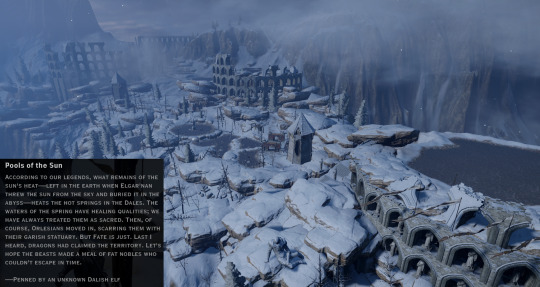
This story can be followed later in the post Emprise du Lion: Pools of the Sun, where we find another unreliable Dalish legend claiming that this place has spring waters because it was here where Elgar’nan shoved the sun into the Earth. I also made a link to Sylaise considering the Elvhenan arenas we can see in this region, the presence of Sylaise’s Shrine, and her thirst for being always competing with someone. These details can make us suspect that this Sun could have been Sylaise [so deeply related to fire, the sun, and also as angry as Elgar’nan according the Song to Sylaise].
It’s very worth noting that these two legends, said by different clans, claim that Elgar’nan pushed the Sun into the Abyss. Another detail we have to assume is that "Abyss", "Beyond the Deep Roads" and "The Void" seem to be one thing related to the places where the Titan sleep [or even inside the Titan themselves] instead of a strange dimensional pocket we never saw before. This links the Elvhenan with the Dwarven in what we speculated in Murals in DAI: The Death of a Titan.
With this relationship, we see again the Sun as a weapon of destruction and control.
[Weak] Elvhenan Culture: Murals
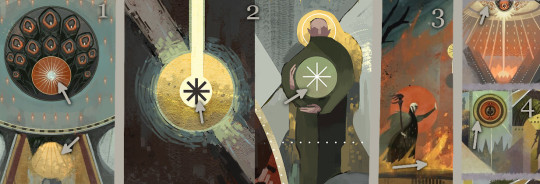
Murals present a red sphere with rays that may imply a Sun .
In the mural “The Creation of the Veil” [1], we find a red sphere inside a black one, making us suspect it’s the big evil released by the Evanuris that Solas isolated with the creation of the Veil. Around it, there are seven “bubbles” with similar “rays” in grey and golden colours that may imply “gates” that would allow us the access to the central “sun” or red sphere.
In the mural “The Death of a Titan” [2] we talked extensively about the asterisk symbol, its representation of a Titan’s heart and all that power associated with it, as well as with Golden Rings. The codex in here speaks of a red sphere that contains fury, and maybe all of this can be related to a sun, or better said, the other way around: a Sun as a sphere of fire, related to fury, and buried below underground to contain its destruction. This also brings us some similarities with the unreliable Dalish legends about Elgar'nan.
In the mural “Red Lyrium Idol” [3] we also commented how the image looks as if Solas were walking on a sphere of fire. It may be related to the red lyrium idol too. Here, we keep linking this idea of a “sphere of fire” as a potential Sun.
In the murals of “The actions of the Inquisitor” [4], we see several times that the red sphere associated with the big evil isolated behind the thick, impenetrable barrier of the Black City seems to be positioned in places that may allow a soft interpretation as a “sun”in the sky.
These symbols seem to gather more importance as we analysed the Vinyl Art, where we find the concept of the Eclipse [as an ominous symbol of Fen’Harel that covers and hides the Sun] and a lot of iconography of stars, which can be interpreted as “suns”.
[Weak] Tevinter Culture: Green Star

Pre-Blight Tevinter art has a “star” symbol that may be interpreted as a sun, specially if we consider that the inside of this green star displays the symbol of the elvhenan Golden Ring in red colour. However, it seems more likely to be a symbol representing the power that one can extract from the Breaches. The green colour helps in this interpretation and puts it a bit farther away from a sun interpretation than other symbols. However, it keeps linking the Golden Ring with the power of creating a Breach.
[Confusing] Tevinter Culture: different decorative elements
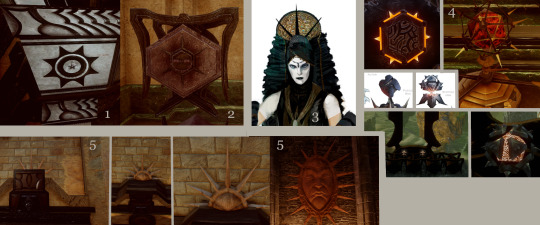
The rest of the symbols in Tevinter objects may have some relationship with the Sun. For example, we find doors, boxes, and columns decorated with an 8-pointed star [1] but we also find another one with 6 points in something that looks like a box [2]. The shape of an “hexagonal” sun of 8-pointy rays can be found as well in objects like the “scrying orb” [4].
Among the outfits, we find a 3-ray comb used by Tevinter women [3], which may be related to the sun-based symbol of an Old God [and potentially related to the corresponding Evanuris associated with it]. This symbol is a lot closer to the "Sun-head creature" we found among Elvhenan objects.
As a curious one, I will always point out the strange, hidden Sun figure that belongs to the Free Marches decoration that can be found at the entrance of the Inner Sanctum in Western Approach: The Still Ruins, Viridis Walk and Inner Sanctum.
I think it’s clear and safe to say that most of the sun-based symbols present in Tevinter culture [and previous to their conversion to Andrastian religion] may have been originated from the contact with the Elvhenan [during the Dreamer time where we can see less repulsion to Elvhen according the Tevinter Mosaics] or [most likely] with the dragons that may have been related to the Elvhenan, as I made the connection in the comic post The Missing.
[Weak] Dwarven Culture: Fairel and Dwarven art
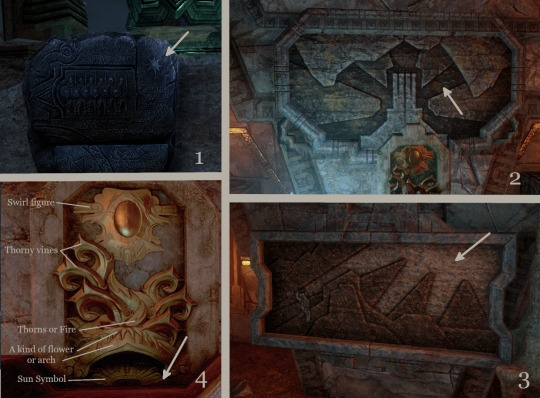
The Dwarves, at least the ones in the Fairel’s ruins, may have some link with the Sun as well. In these ruins we find the same exact stone tablet we find in the Ancient Elvhenan tombs [1], which displays the “crappy sun” I commented above. Once again, it could be a sun but also a breach, so there is no much sense to keep focusing on it.
Another symbol to relate the Sun to the Dwarves may or may not be an old “Dwarven stone-paintings” we saw since DAO, which basically shows a dwarf working the stone [3]. Based on symmetry, we could assume that the triangles on the background are stalagmites, but if we stretch-out this interpretation, they could even be seen as a sun with its rays. It’s very unlikely, since it seems to be more a design resource to highlight the scene of the stone-painting, but for completion’s sake I think it’s worthy to keep it commented here.
However, this simple design allows us to interpret it in different ways: the spikes we see can be pieces of rock protruding from the ground and the Dwarf in it is mining them [as its original codex in DAO seems to imply], but also it could be understood as a quarter of a Sun peeking through the corner of the image as a Dwarf works tirelessly.
Later in DAI we are introduced to another piece of art of similar characteristics [2]. The building was never possible to be identified unequivocally, and in posts like “Architecture of Kirkwall : Gallows and Lowtown/Darktown” I related it to representations of Kirkwall or cities that may be similar to Kirkwall where the runecraft mastery of dwarves was used [and probably, it was a source of pride for these clans, who may have kept the achievement immortalised in a piece of art reproduced among the noble dwarven families]. This piece also shows a background very similar to the one in [3] that may be a representation of stalagmites or a sun, if it’s stretched-out enough.
Another strange symbol in the dwarven furniture is the one presented in some stone-seats: an elaborated metal image that shows thorny vines on or over a sun [4]. This symbol appears in many other parts of the game where there are dwarven rooms, but also in Arbor Wilds :Cradle of Sulevin where we can read the Vir Tanadhal, However, in this case, the symbol is not completely the same one than in the Hissing Wastes: Fairel tomb.
It’s hard to suspect if this is a mere reuse of assets, it has a lore-related meaning, or it’s just a reflection that the Dwarves and the Ancient Elvhen had a relationship quite ancient [as it shows the Elvhen tree and its dwarven, more geometrical style, that I’ve been pointing out since DAO in Orzammar]. We have to remember that the Ancient Elvhenan saw the dwarves as soulless creatures, workers of the “pillars of Earth” and worthless. However, I always claimed it was never clear if this was a reference to ancient Dwarves that were linked to the Titan deeply to the point that they became Sha-Brytol after the break of the link, or were related to more independent dwarves as the ones we see now, who have a sense of Stone, but can’t understand the Titan with the exception of some gifted ones [such as Valta].
Finally, the dwarves have an additional aspect related to the Sun in the very unreliable codex called Torn Notebook in the Deep Roads, Section 2. I wrote about this codex in a more integral way in Deep Roads [DLC Trespasser]: Lower Walkways. But basically an ex-Dalish elf [now a Qun converted] relates Elgar’nan’s fire [which another unreliable Dalish legend, Elgar'nan: God of Vengeance, claims he shoved the Sun into the Earth] to the fear to the Sun that Dwarves experience [Read the section Elgar’nan and Sylaise above]. This may have been a Dev’s choice to makes us aware that there exists a relationship between the Sun and the dwarves, even though there is no lore material that can make it clear enough.
[Strong] Ferelden Culture: The Sun Face and the geometrical Sun

In the Tryptich presented in Andrastian Design: Tapestry and Tryptich, we find three symbols on top of each part of the scene: the six-snakes that represent Tevinter, the golden city above all the image representing the Maker or the Chantry Religion, and over the section of Ferelden/Orlais chantry, a 8-pointed sun which rays look like triangles. Once again, the resemblance of this symbol with the elvhenan sun in the mural “Temple of Mythal” is remarkable [check the Temple of Mythal in “The actions of the Inquisitor”] or the sun shape in the elvhenan yellow mosaic or in the background of Solas in the Trailer of DA:D. This could come from different roots:
1- An Orlesian root, considering how much of the elvhenan influence it had during the time of the Halamshiral and the coexistence of humans and elves in the Dales for some years [to the point where inter-racial families were made, as it was hinted all over the Exalted Plains]. I spoeculated how the idea of the Maker may have been developed during this time in the post The Chantry and the Mythology of the Chant of Light
2- Another potential root is related to the Alamarri root, and therefore, linked to the Avvar: this sun may be a representation of the Lady of the Sky for the same reasons I will explain below in the Section Avvars and the Sun.
We can find similar icon in the book World of Thedas, where they show a unique Ferelden Tryptich [3], which top displays this symbol with a sun that even may have a shape of a Golden Ring within it. In either case, we know that this symbol later was part of the Ferelden Chantry, which sun is very pointy, as DAO showed it [see the first section in this post: Chantry Sunburst].
In DAI, we find in some small towns of Ferelden, a unique strange Sun with a crying face [1]. On it we see a bird and a squirrel. It’s hard to know exactly what this is, [check the post Nation Art: Ferelden], but maybe it can be understood as a representation of Andraste made by Ferelden culture mixed with some local animals and fables created as a mixture of cultures, similar to the tale that related Wyverns to Andraste [check the wyvern section in Dragon Age Iconic Patterns: The single spike].
There is also a fish drawn in the DLC of Hakkon on a fisherman shack [2], which displays a pattern that can be related to the “crappy sun” designs on its skin. Not sure what to make about it. The closest is that the Avvar represented this symbol as a way to reflect what they may have seen in the Isle of the Lady, where a big ancient breach have been there, open, since the time of Telana [read about this in “The Veil and the preservation of the Waking World” from the post Frostback Basin [DLC]: Miscellaneous ].
[Strong] Grey Wardens and the Sun

The typical symbol of the Grey Wardens involves a chalice that represents the Joining ritual. It always displays a Sun, and not any sun: it’s one with a strong resemblance to the Sunburst of the Chantry. Let’s remember that the Grey Wardens was and is an independent Order that doesn’t respond to the Chantry, and even more so: it was created before the existence of the Chantry, and before Andraste was born. So any quick explanation that this sun is present in this object due to some potential influence from the Chantry seem unlikely.
However, as I showed in Western Approach: The Still Ruins, Main Chamber and Hall of Silence, there are griffons with this same chalice that belonged to pre-Blight Tevinter, maybe remotely associated with Dumat in some ways [since they appear in a hall called “Hall of Silence”, and Dumat=Silence]. We know that the Joining, as a ritual of blood magic, came from the knowledge of Arlathan elves and Tevinter Mages during the desperate times of the First Blight when nothing seemed to stop the darkspawn and even slaying Dumat did not work the first time. Therefore, this Sun may have some relationship with the elvhenan, the Old Gods, or just the blood magic that allowed the creation of the Joining.
[Curious] Avvar and the Sun
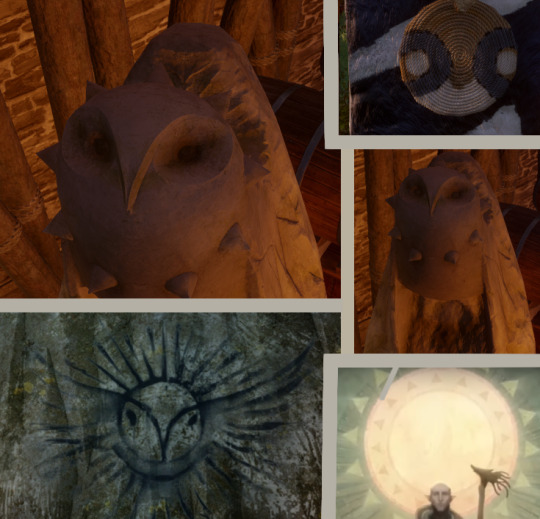
The Avvar have a symbol that I always found very Sun-like due to its design and cultural concept: The Lady of the Sky. It’s not only the concept; the lady of the sky can be any important object in the sky; moons or suns. Since Thedas has two moons, it seems more plausible to think of her as unique as the Sun itself.
In the painting that represents her (found on a wall in the Frostback Mountains) we see a design of an owl which shape looks like a Sun. Even her sculpture in Skyhold displays small spikes around her neck which give her a low-key “sun-like” design, specially if we relate this shape with the “sun” shape we saw in the Ancient Elvhenan Yellow Mosaic or with the star we saw in the “Temple of Mythal” mural [in “The actions of the Inquisitor”] or with the Sun that appears behind Solas in the trailer.
Curiously, her banner displays her eyes in a shape that looks similar to the Golden Ring shape, but in black colour. That the Avvar have an art that may have resemblance with Elvhenan's is not strange for me if we remember that Tyrdda Bright-Axe Path’s story narrates that her lover was an elf that, as it is hinted, may have been the Lady of the Sky herself. This means that the Avvar always were a culture under the influence of the Elvhenan and the Dwarves [due to the marriages they arranged with the children of the Stone].
[Weak] Flemeth
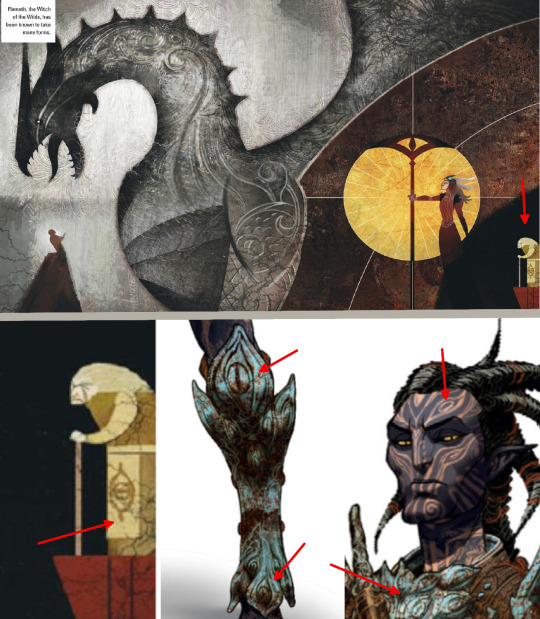
Flemeth also had a unique concept art that shows all of her nature in one drawing: her dragon shape, Mythal, as the central part of it over a human figure that may be a petitioner; a bit aside and as if she were in a inner ring of a brown sphere, The Witch of the Wild: Flemeth, with a very particular staff inside a yellow circle that may be interpreted as a Sun. And very hidden in the corner, in the core of this sphere, now black, we see her as an "old, old woman" with a big eye drawn on her apron, at the edge of a cliff [potentially representing the fragment of Mythal that lives inside her]. This kind of eye is very similar to the ones that we see in the concept art armours of Mythal’s temple guardians. I assume it has to do with her omnipresence due to the manipulation of dreams [we know that she presented herself in dreams to an elf and marked him with the Vallaslin of Mythal after awakening, check the video]
Mythal also has bland hints related to Elgar’nan symbology, which is related to the sun, fire, and balls of fire with anger [check all this in the posts Speculations about the Vinyl Art and “The Death of a Titan”]. Flemeth ends up being related to all this since she carries a fragment of Mythal in her.
[Strong] Qunari, Par Vollen, and the Solium Constellation
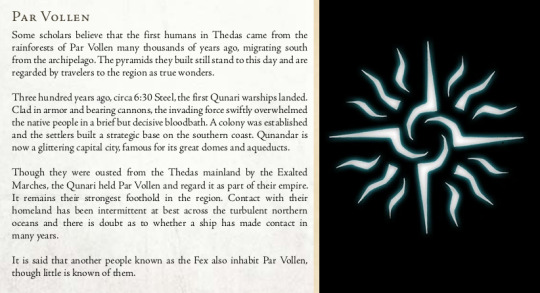
The Qunari have little link with the Sun, but not the land they conquered. In the book World of Thedas we are informed about the existence of the Fex, a race we never saw nor had much information beyond the fact that they exist. May they be related to the Sun or a Sun-base proto religion? We don't know.
In the Codex Constellation: Solium, we learn that this constellation [which looks like a Sun/Star, image above, pretty similar to the Chantry Sunburst I may add] may have been a representation of the Sun or the Moon [or both] for the Neomerian [Ancient Tevinters], however, it could also represent Elgar’nan, since unreliable Dalish legends claim him to be the “eldest of the Sun”.
Another Codex, called The Pyramids of Par Vollen, tells us that the Jungles of this continent have ancient ruins that doesn’t seem to be tombs but places of scientific purposes. The shape of these ruins fits perfectly with the constellation of Solium, making them, in some way or another, related to the Sun. These pyramids are a great mystery in the DA lore, especially for their total lack of information beyond this codex. We know their walls show images of “intricate sea creatures, shipwrights, musicians, archers, and kings. Odd figures are depicted, tall, horned, always in a position of authority and respect.” It seems that there was no resistance when the Qunari came to conquer this place, so we can suspect that this previous civilization embraced the Qun without much resistance, in part, because the Qunari have horns, and that caused respect and authority. Or the civilisation had been gone long ago when they came. Or it was a civilisation that was developed by or under the authority of the Kossith, the ancient Qunari who had no Qun.
The brief description of these ruins also makes me link it, potentially, with the underground ruins we find in The Horror of Hormak .
[Confusing] DAO design
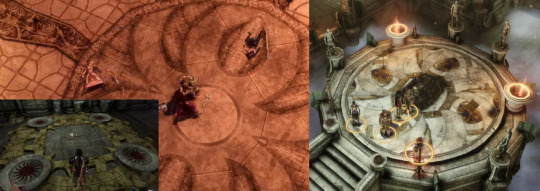
This section tries to relate the Sun shape with designs that may make the connection a bit stretched or not truly reasonable, therefore, DAO leads this part, lol.
We find that many places along the game, specially the ones related to puzzles [Honnleath and Enchanter Wilhelm’s basement] or to Tevinter experiments [Ruins of Brecilian Forest] display a platform on the ground with a symbol similar to the Sunburst of the Chantry. I’m not sure why they are there, specially in the Brecilian Forest, since we know this was a fortress probably developed by Tevinter [ which potentially may have co-opted, as usual, an ancient Elvhenan building and claimed it as its own] just to be taken by Dalish and humans later. This Fortress is a mess in terms of design and statues that it displays, so it’s hard, if not impossible, to truly take it seriously. To me it all feels more like a reuse of graphical resources, but just for the sake of completion, I add the present section.
More of these sun-like platforms can be found in the Tower of the Circle of Magi [which could potentially make sense since the tower was made by Avvar and Dwarves, and it may be a representation of the Lady of the Sky, as we saw in the Avvar section of this post] but also in the Temple of Andraste or in Denerim at the Fort Drakon which makes less sense [unless it is taken as a symbol from the Chantry itself]. Again, these inconsistencies make me suspect the reuse of assets in a game that could not afford to have 5 different platforms designs.
[Confusing] Free Marches Rural Areas
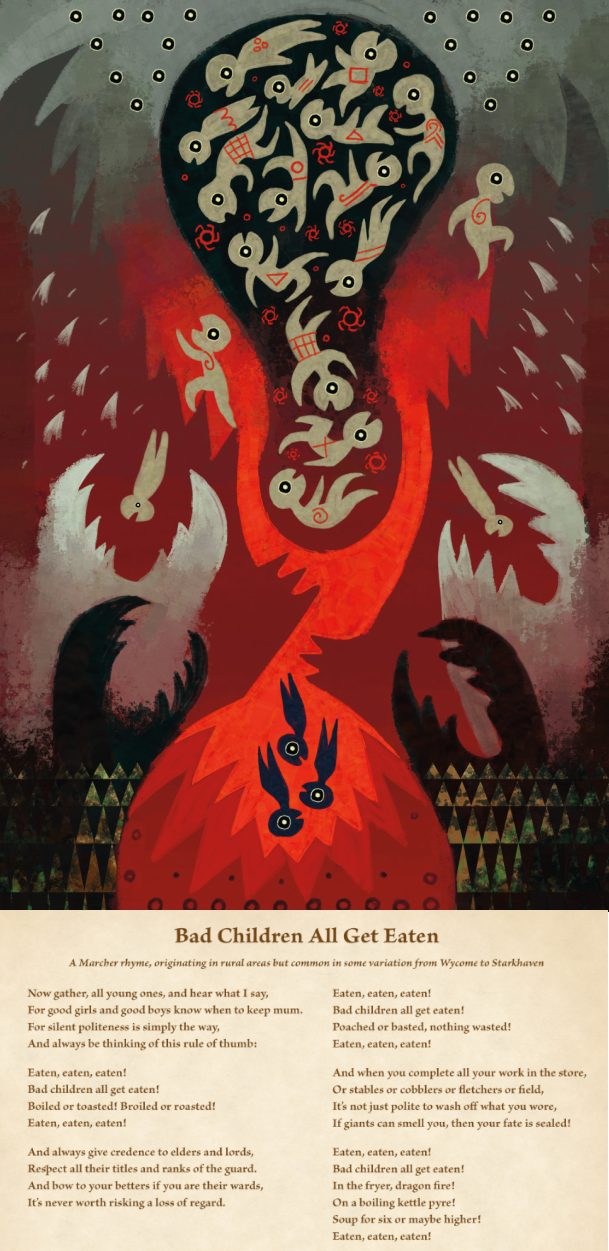
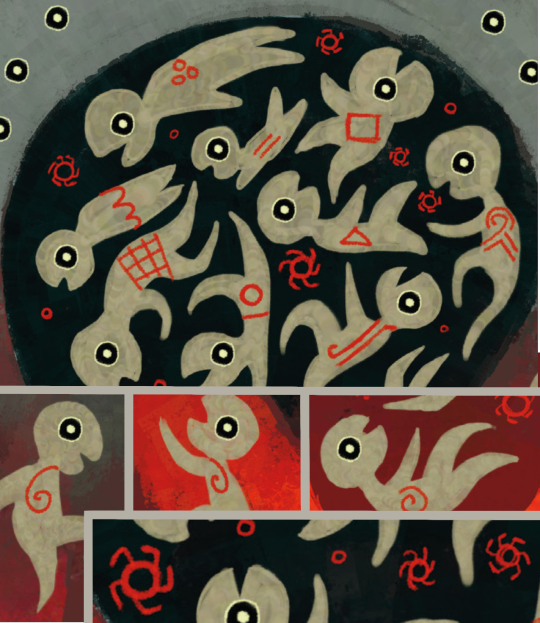
Another place where I found a sun-like symbol was in a very disturbing image of the book World of Thedas associated with a cautionary tale told to Free Marches kids. In it, we see that people/children are punished if they go outside a bubble of darkness with small “sun-like” symbols floating around. Each of these kids have a symbol on their belly or head. Curiously, one of these symbols is a small spiral that I’ve brought the attention upon long ago in the post Hinterlands: Statues, paintings, and structures found in the open where we found the alamarri statue I called Eroded dragon skull which has a “G symbol” on its back, which, at the same time, seems similar to the one present in a reiterative way all over the elvhen artefacts and in some dwarven rug designs.
I don't know how to interpret this image, mostly like the big black bubble that contains these klids seems to protect or shield them from the dangers outside. The kids that "behave badly" are dropped outside of it and are consumed by the dragon fire/jaws of the dangers outside. So in a very stretched way, we can interpret this image that the bubble filled with Suns protects people, or at least, it's the right path to follow not to be eaten by those monsters outside.
Conclusions
To put an end to this post, I would like to bring a short conclusion that we may have reached together along it. The Sun in Thedas is an ancient symbol that mostly every culture took to exploit and use in their own representation of gods/power.
This fact alone is not strange, since in anthropology we can see that severals cultures on Earth have developed religious rites or created Gods out of the Sun itself. The Sun is a symbol related to warmth, light, food, life, and security, so it seems reasonable for DA Lore to take it as the main symbol of Thedas civilisations.
The Sun in current Thedas is immediately associated with the Chantry and Andraste: it is a symbol of hope, of dawn, that provide the idea of new beginnings; it’s also the idea of the Maker itself and the Faith people have in him. It's also the fire that purifies in order to grant ascension [Andraste's case].
When it comes to Elvhenan, the Sun is immediately related to Elgar’nan, who was considered, according to the underaliable Dalish legends, the son of the Sun itself, who in order to save the Land shoved the sun into the ground, potentially causing a great damage to Dwarves and Titans.
There is also a symbol of a half-sun in an Eluvian, a statue, and in a hat worn by an elf, that may suggest that an original god, represented by the sun [potentially an ancient Dragon] was worshipped by the Evanuris. Lately, that symbol may have been co-opted by one of the Evanuris when they took divinity and the identity of the ancient gods they worshiped.
Elvhenan also seem to take the symbol of the asterisk as an oversimplification of the Sun, which across the murals, is also related to the heart of Titans, to power, and to the Golden Ring, which is also associated with control. So, for Elvhenan, we may suggest that the Sun represents immense power, if not, Divinity itself, that may end up being related to the core of Titans. The asterisk is also associated to the orb, a big power object.
Since Elvhenan were the first civilisation we know that started in Thedas [besides the Titans and their children], their symbols of power [asterisk, orb, golden ring] may have evolved along time to reach human groups which developed, later, all the sun symbols that ended up in the Chantry’s.
Thanks to Tevinter, we also can suspect that the Sun may have been a representation of an Old God, since they have a lot of sun-related images in their decoration and objects that belong to ancient times in which they were not Andrastian yet [in fact, so ancient times that Andraste herself was not born yet]. This may mean that the Sun symbol cloud have been taken from the Elvhenan or from the Ancient Dragons. Through Tevinter style, we also realise that the Elvhenan Golden Ring may have been used to create Breaches, which again shows and seems consistent with the idea of relating it to power and control. The symbol of Sun in Tevinter culture may be related originally with Elvhenan or with Ancient Dragons that Tevinter used to worship.
Dwarves have little representation of the sun for obvious reasons, but due to the unreliable legend of Elgar’nan and the war with the Titans, we may establish a relationship in which the dwarves endured the Sun [or the Elvhenan power] at some point in their story.
Thanks to the Grey Warden we can relate a sun with the idea of ancient Blood magic or ancient Dragon blood knowledge, since the Joining is represented by a chalice with a Sun on it.
The Avvar also have a low-key representation of the Sun in their Lady of the Sky, which may be just consequence of their deep relationship with the Elvhenan culture.
Par Vollen may have more answers about the Sun and ancient times, but the lore of DA world is very scarce on this region of the map of Thedas, so we can only speculate.
#Analysis and speculation of Statues#golden ring#alamarri#avvar#Chantry#Dragons#Elvhenan#Flemeth#Grey Warden#High Speculation#Old Gods#Tevinter#Par Vollen#sunburst#Sun-head creature#evanuris#Elven Ancient Shard-based door#yellow mosaic#mythal#flemeth#Elven Owl statue#Stone in Razikale-Ceremony-style#Sylaise#Elgar'nan#Asterisk Symbol#Free Marches Sun#Dwarven stone-paintings#lady of the sky
75 notes
·
View notes
Text
So just to shit some more on the executors, and the "reveal" they were behind everything...

Acording to the secret ending, they were the ones actually behind the tevinters breaking into the fade and the golden city.

But from the black codex, we know that the voices that spoke to the Tevinters, and by extention playing the role of their gods, was actually the will behind the blight itself, the song that the darkspawn hear, using it's one, original link to the physical world(The trapped and blighted evanuris', dragons) to orchestrate an escape.
That has some pretty massive lore implications, and frankly would have perfectly explained how the actual dragons aren't actually anything more than empowered High Dragons, if this reveal had actually been in the game... But it also pretty much makes the executors being behind the first breach into the black city and the following blight impossible.
We KNOW who the big player behind the scenes is. We KNOW their motivation. We KNOW how they did it, and through the rest of the black codex we know how the Blight came into existence.
There simply isnt any room for a secret evil cabal here pulling the strings behind the scenes, even if there was motivation to, which is contradicted because what little we do know of the Executors motivations before this stupid slideshow of retcons, is that they were hellbent on actually preventing the veil from going down and unleashing the blight into the world.
#dragon age veilguard#dragon age#tevinter imperium#magisters sidereal#the black city#the blight#the executors#retcons#old gods
15 notes
·
View notes
Text
it really frustrates me that the main (only?) thing you can really do with the dragons in dragon age is kill them
this is wild enough as a player, but in-universe it is downright monstrous. an extinct species reappears and is such a major deal that the church names the whole ass century after it, and everyone immediately rushes to *start making them extinct again*
#dragon age#iron bull is a big game hunter#given the link between the tevinter old gods and archdemons there's possibly SOME justification#but that doesn't really ever come up?#people are just back on their all-dodo diet
15 notes
·
View notes
Text
got bored and decided to take a look at my old dragon age pinterest board and found some fan theories about what would happen in da4 based on the worldstate inquisition left us with… oops, now I’m very very sad 🥲
#dragon age#datv critical#found a post with a long list of socio-political implications with Solas’s elf faction#and the whole Tevinter vs the Qun thing#and what Mythal might do with Kieran’s old god soul#and of course the well of sorrows#ah yes. let me wallow in all they’ve taken from us#I don’t know if I will ever not grieve for what could have been
12 notes
·
View notes
Text
{Spoilers-Theory} Old Gods = Elvhen Gods Part 2
Originally posted 2nd June 2022
To start let's recap where we left off in Part 1.
Recap:
There are 7 banished Evanuris and 7 Old Gods.
The ‘Sinner’ took the form that is reserved only for the ‘divine’ (Evanuris) and their chosen. (Speculation; this form is a Dragon / High Dragon.)
All surviving iconography of Mythal depicts her as a dragon or having draconic features.
There is a plausible 8th Old God that was struck from record, according to scholarly debate in in-game canon (Codex entry; Draconis). (Speculation; this is possibly referring to Mythal, as she is the 8th (and last) Evanuris.)
{8 Dragons & The Dread Wolf}
What do I mean when I refer to Mythal as the eighth and last Evanuris?
I’m not convinced that Fen’Harel/Solas was ever considered one of the Evanuris by his contemporaries in ancient elvhenan and we have overwhelming evidence that he is not considered one of the ‘Creators’ by present-day elves. Although, all information that has survived the fall of elvhenan has a pro-creators/evanuris slant due to enduring propaganda, so we’ll have to take it with a pinch of salt and speculate the ‘fact’ from the ‘fiction’.
Solas is revealed to be Fen’Harel in Trespasser, either by revealing himself or unlocking the secret dialogue option by collecting 4 codex entries and calling him out. During the climax of the DLC your Inquisitor is given the opportunity to talk with him and his dialogue offers some insight.
Throughout the entire conversation trees, Solas does not consider himself one of the Evanuris.
There are subtle differences in dialogue whether you are an Elven PC or not, and whether you are romance or not with Solas. I’m using the conversation tree for a romanced female Lavellan. There are handy resources out there, I’ve found the Female Lavellan dialogue tree in image format here and The Genitivi Chronicles has transcribed Trespasser and can be found here.
Inquisitor: The Evanuris were elven mages? How did they come to be remembered as gods? Solas: Slowly. It started with a war. War breeds fear. Fear breeds a desire for simplicity. Good and evil. Right and wrong. Chains of command. After the war ended, generals became respected elders, then kings, and finally gods. The Evanuris.
Inquisitor: You love the Fade. Why would you create the Veil to hide it all away?Solas: Because every alternative was worse.Inquisitor: Meaning?Solas: Had I not created the Veil, the Evanuris would have destroyed the entire world.
Inquisitor: You said that the elven gods went too far. What did they do that made you move against them? Solas: They killed Mythal. (Chuckles.) A crime for which an eternity of torment is the only fitting punishment. Inquisitor: I thought Mythal was one of the Evanuris. Solas: She was the best of them. She cared for her people. She protected them. She was a voice of reason. And in their lust for power, they killed her.
In none of the Evanuris directed dialogue do we hear Solas refer to their kinship, always saying ‘them’ and not ‘us’. This could be a case of disassociation and distancing himself from the Evanuris, and this response could be used in defence of that speculation.
Inquisitor: You banished the false gods—you didn’t kill them? Solas: You met Mythal, did you not? The first of my people do not die so easily. The Evanuris are banished forever, paying the ultimate price for their misdeeds.
“The first of my people do not die so easily.”Is he referring to the Evanuris as his people or the elvhen as a whole? I would speculate that the latter is the most plausible, especially since elvhen in the common tongue would translate as ‘The People’ and that the Evanuris have been revealed (in the prior conversation) to be elven mages.
A possible breakdown; ‘El’ - The/the (definite article) ‘Vhen’ - People
This stance apart from the Evanuris is also found in the Dalish legends. Humorous indeed that the dalish might be correct about this, however is it stemming from evanuris propaganda and/or the prejudices of the survivors of Elvhenan?
From the Codex entry: Fen’Harel: The Dread Wolf
“…In ancient times, only Fen'Harel could walk without fear among both our gods and the Forgotten Ones, for although he is kin to the gods of the People, the Forgotten Ones knew of his cunning ways, and saw him as one of their own. …” “… Our gods saw him as a brother, and they trusted him when he said that they must keep to the heavens while he arranged a truce. …”
That lends to the question of who and what are the Forgotten Ones? But that would be a topic for another day. Part 2 is short and sweet but Pt.3 will delve into the Tevinter Imperium’s Old Gods and how they relate (or not) to the elvhen Evanuris. Til then, take care!
#BDTinFoilTheories#dragon age#Dragon Age Theories#spoiler warning#tevinter old gods#evanuris#elvhenan#Bor-Dirth'ena
3 notes
·
View notes
Text

#dragon age the veilguard#old gods of tevinter#everyone can go home the most important lore discovery is in#crysandthings
7 notes
·
View notes
Text
Meet the Myths: Lusacan
Introducing the myths and legends of Dragon Age Annual 2025: Legacies! The old god Lusacan features in art as part of our zine, Sagas.
Click Here to order DAA 2025: Legacies NOW!
Orders Close:
Physical Copies & Merch: October 31st
Digital Calendar & Zine: January 31st, 2025

Codex Entry: The Old Gods
There were seven Old Gods, great winged dragons that were said to rule over the ancient world. The Chantry maintains that they are responsible for the original sin, that they turned humanity away from its true creator through deceit. Humanity's faith faltered, and thus the Maker turned away from the world—but not before trapping the Old Gods in eternal prisons beneath the earth as punishment. Regardless of the truth, legend maintains that even from their underground prisons, the Old Gods were able to whisper into the minds of men. The Archon Thalsian, first of the Magisters, who claimed to have contacted the Old God Dumat, used the blood magic Dumat taught to him to attain incredible power in Tevinter and declare himself the ruler of an Empire. In return, he established the first temples worshipping the Old Gods, and the dragons became equated everywhere with imperial power.
—From The Old Gods Rise Again by Sister Mary, Chantry scholar, 8:50 Blessed
#lusacan#the old gods#tevinter#dragon age lore#dragon age codex#dragon age#zine#fandom zine#charity zine#dragon age zine#zine preorders#zine preorders open#dragon age annual#dragon age annual 2025#fandom events
6 notes
·
View notes
Text
Ok playing veilguard as a shadow dragon elf. Aka an elf from tevinter. Which I do wish that was like... addressed more. In general. But Also makes all the elf dialog kind of weird??? Bc I dont think my elf would've been raised with any of the elven god stuff. So anytime Bellara talks about how we're fighting "our" gods, I'm just like. Not Really, for me... I wouldn't say that to her even if I could but like. Still feels weird.
But ALSO this framing of the elves as somehow culpable for all of this??? I know it's just Bellara's hyper-empathy so she's feeling guilty, plus she's Dalish so she hasn't dealt with the shit that city elves do... but it REALLYYYY feels like this game is sweeping all of that under the rug. Like what happened to all the bigotry we saw against the elves for several games??? Does the city elf origin in origins mean nothing to you???? This idea that A: the elven Gods are actually evil, so the modern elves are stupid for worshipping them and trying to keep their culture alive despite adversity, and B: that elves as a whole are somehow even POSSIBLY responsible for anything their gods do (thus feeling like the game is going Well, Actually, the bigotry was justified the whole time)
It SUCKS!!!!!! I hate it!!!!!!!!!! And I know this game takes place outside of Ferelden so things are different this time, which especially makes sense for how mages are treated, but we've SEEN how badly elves are treated regardless. Does Fenris mean nothing to you!?!??!?!?!
😭😭😭😭😭😭😭😭 like I'm having a lot of fun with this game but there r a lot of plot points that are just like. Must we?????
#speculation nation#fanny plays dav#datv spoilers/#and like i was annoyed at how inquisition retconned how dalish elves treat their mages#but this feels worse. bc this is about the culture as a Whole.#just. ugh!!!!!! i hate it!!!!!!!#and like see if it werent for that cultural context itd be kinda cool to be fighting old gods or whatever#but having it be that a marginalized people who are clinging to their culture for their senses of cultural identity#are actually 'wrong' and painting them as stupid for it??? it just puts a really sour taste in my mouth.#tempered slightly by them being like. the tevinter gods werent real either and also the Maker is also implied to not exist#given that one dialog about the Golden City never actually existing. like ok at least it's not Only the elven gods getting this treatment.#but they are still INCREDIBLY in focus for it. vs the one passing dialog in one single scene about how the Maker might not be real.#idk. it bugs me. i dont like this.
2 notes
·
View notes
Text
it's so fascinating to me how people in thedas have just placed their holidays at regular intervals throughout the year instead of at culturally or religiously relevant times and just. not added any new ones ever.
i guess they just don't have the concept of "a holiday is a celebration of a historical/religious/spiritual/astronomical event" so it never occurs to them to add one to make anything from andraste's life or the foundation or the chantry or the fall of tevinter or the end of any blight --- for elves anything from shartan's rebellion or the founding/fall of the dales, for dwarves anything with paragons or just out of their very long known history thanks to the shaperate. it seems the chantry at least have rebranded some of them, so all soul's day celebrates andraste's death, which yes that makes sense, that's christmas and maybe easter too idk, but they don't seem to have added any. it's just, no we have these five holidays, they happen at these dates, if you want to celebrate something on any other date we can't help you.
#ooc�� ( bird noises )#the fact that tevinter took elven holidays and made them about the old gods#and then the chantry took those holidays and made them about the maker#very believable that it's how it goes#explains why the dalish celebrate on the same day#(im on the wiki now and oh solstice is a thing#which is interesting#i wonder if the equinox would be too
4 notes
·
View notes
Text
*david duchovny voice* what are dragons??
#no listen#idk where we got this but at my house we call it the dreadwolf ‘iceberg theory’#and like. i could go in a whole ted talk but other ppl prolly already have so just. listen linda#i’m high key wondering if the tevinter old gods that get corrupted into arch demons are connected to the evanuris#and also if so… what are dragons anyway???#im probably way off the deep end lol but this occurred to me while fucking around in crestwood so here. have some brain worms tunglr#antares speaks#dragon age
5 notes
·
View notes